Week 06 - Communication Skills
A presentation at Heritage University at CBC Week 06 in in Pasco, WA 99301, USA by Jacob Campbell

SOWK 486 Fall 2020 Planning: Class 06
Location: Online - Zoom
Time: Monday’s from 5:30-8:15
Week 06: 09/28/20
Topic and Content Area: Communication Skills
Reading Assignment: Hepworth et al. (2017) chapters five and six
Assignments Due:
- A–02: Asynchronous Class Engagement Communication Skills Teach-Back Video Post by Friday 10/02/20 at 11:55 PM and two replies by Sunday 10/04/20 at 11:55 PM via my Heritage Course Forums
- A–03: Reading Quiz for chapters five and six is due at 5:30 PM before class via My Heritage
Other Important Information: N/A
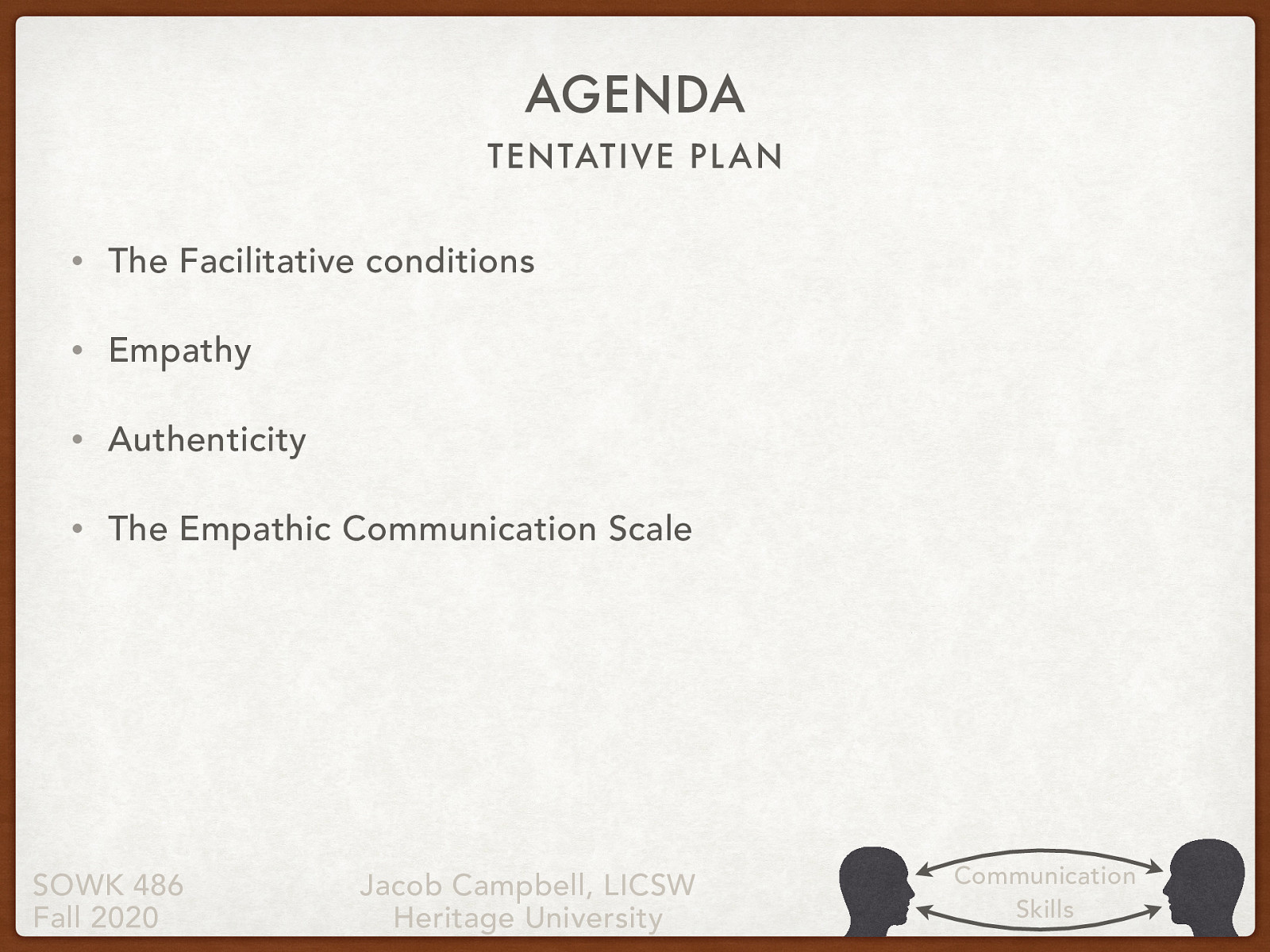
Agenda
- The Facilitative conditions
- Empathy
- Authenticity
- The Empathic Communication Scale
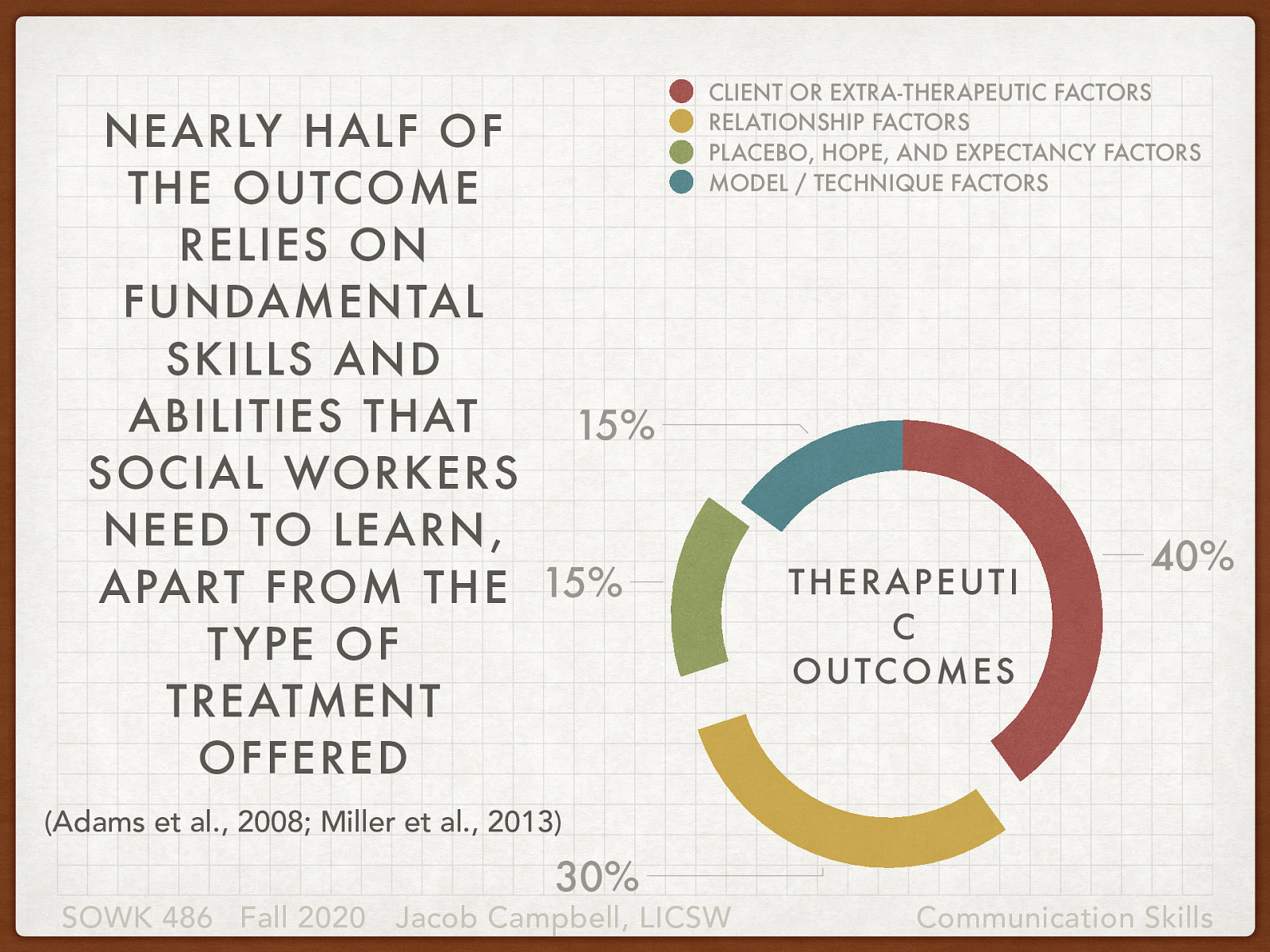
Treatment Outcomes
As we have talked about, relationship and client belief in the process is key to having positive outcomes.
Nearly half of the outcome relies on fundamental skills and abilities that social workers need to learn, apart from the type of treatment offered (As cited by Hepworth — Adams et al., 2008; Miller et al., 2013)
Factor | Percentage —- | —- Client or extra-therapeutic factors | 40% Relationship factors | 30% Placebo, hope, and expectancy factors | 15% Model / technique factors | 15%
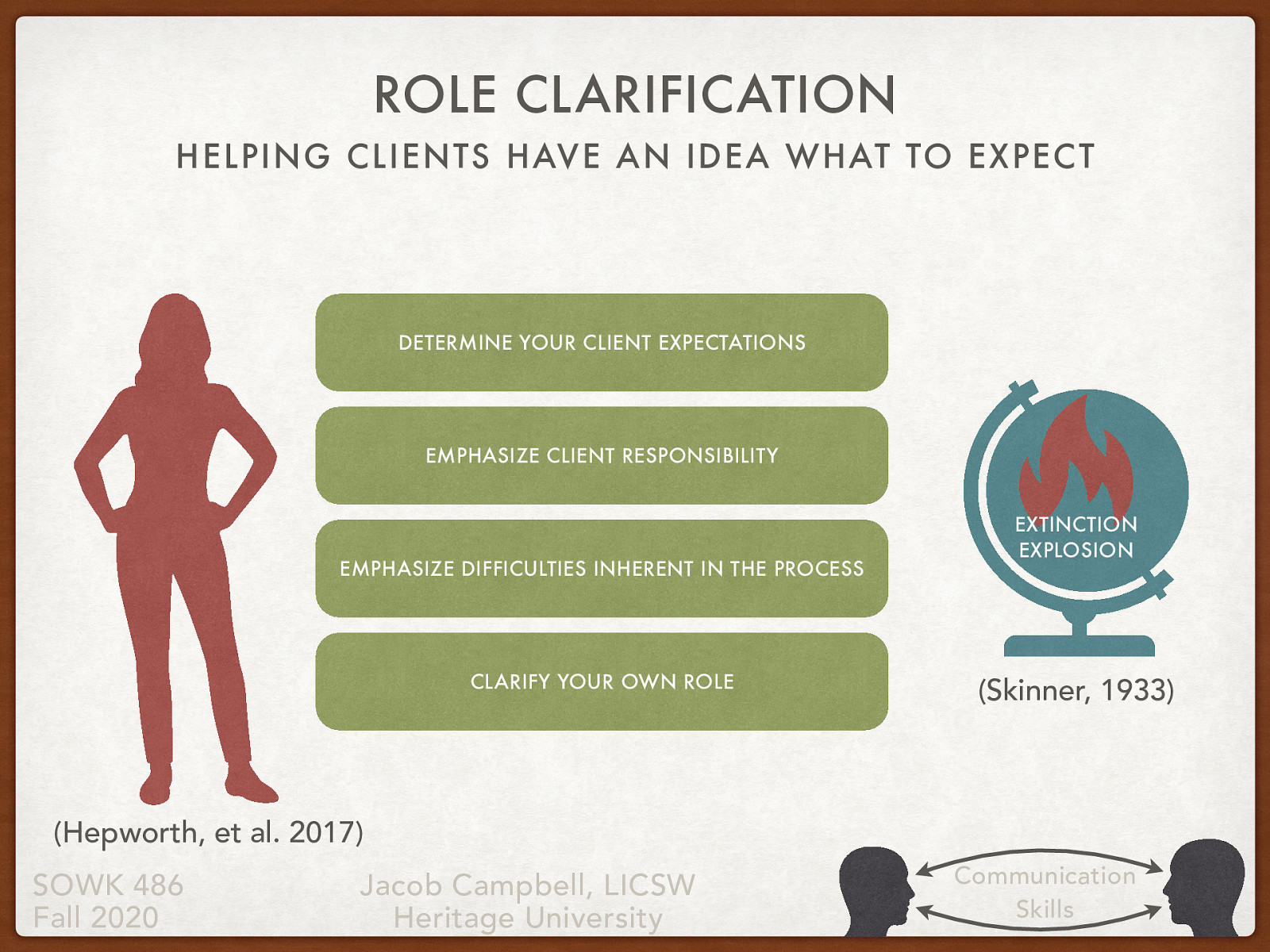
Role Clarification: Helping Clients have an idea what to expect
“Clients often have an unclear idea about what to expect from contact with a social worker, and those ideas may differ from the social worker’s expectations as well (Kadushin & Kadushin, 1997). This is most evident when the client has been referred or mandated for service. Clarifying expectations becomes a key intervention in work with clients who have not chosen to see a social worker (Rooney et al., 2009; Trotter, 2006).”
- Determine your client expectations: Ask questions to determine what their expectations. Help them to manage unrealistic or unreasonable expectations.
- Emphasize client responsibility: What are the expectations that you or others have on them.
- Emphasize difficulties inherent in the process: Making change is hard. Extinction burst.
- Clarify your own role: What will you be doing and expectations they can have on you
[Small Group Activity] I’m going to be breaking you up to talk about your assignment… spend some time clarifying your own roles in that.
B. F. Skinner (1933) “Resistance to Extinction” in the Process of Conditioning, The Journal of General Psychology, 9:2, 420-429, DOI: 10.1080/00221309.1933.9920945

Discrete Verbal Following Skills (01 of 02)
You all are going to be participating in teach-back activity over the next couple of weeks.
- Discuss connection with other in cohort (do you have a group?)
- Discuss activity in general
- Discuss what will be doing
- Discuss how to assign topics / teams
-> Slide
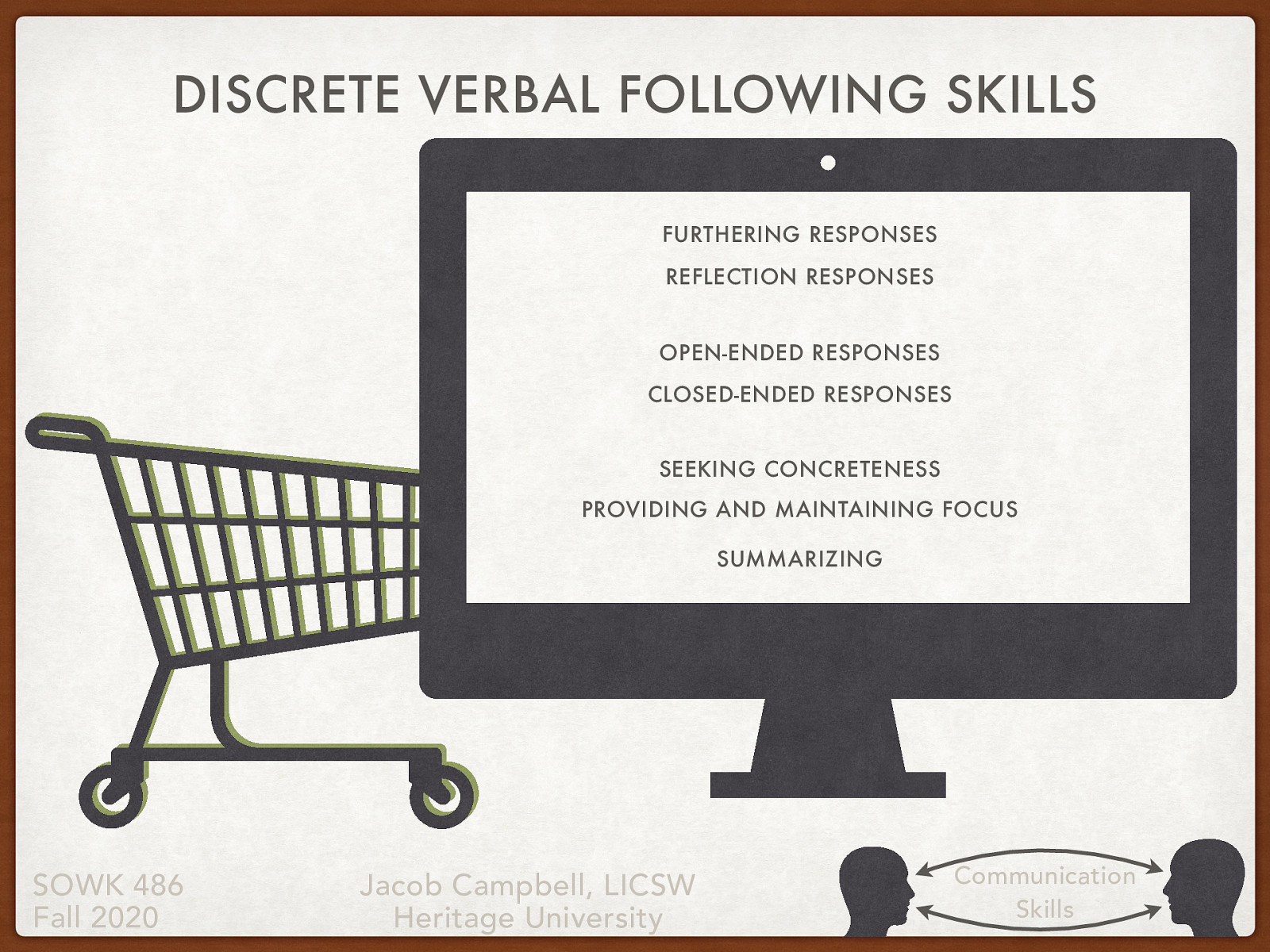
Discrete Verbal Following Skills (02 of 02)
The discrete verbal following skills include:
- Furthering responses
- Reflection responses
- Open and Closed-ended responses
- Seeking concreteness
- Providing and maintaining focus
- Summarizing
You will be making a 10 -15 minute video teaching one of these skills. Longer description listed in My Heritage…
Your goals right now are to do the following:
- Make sure you have each others contact information
- Help to clarify some of the roles that each of you have in your group
- Discuss initial overview plan
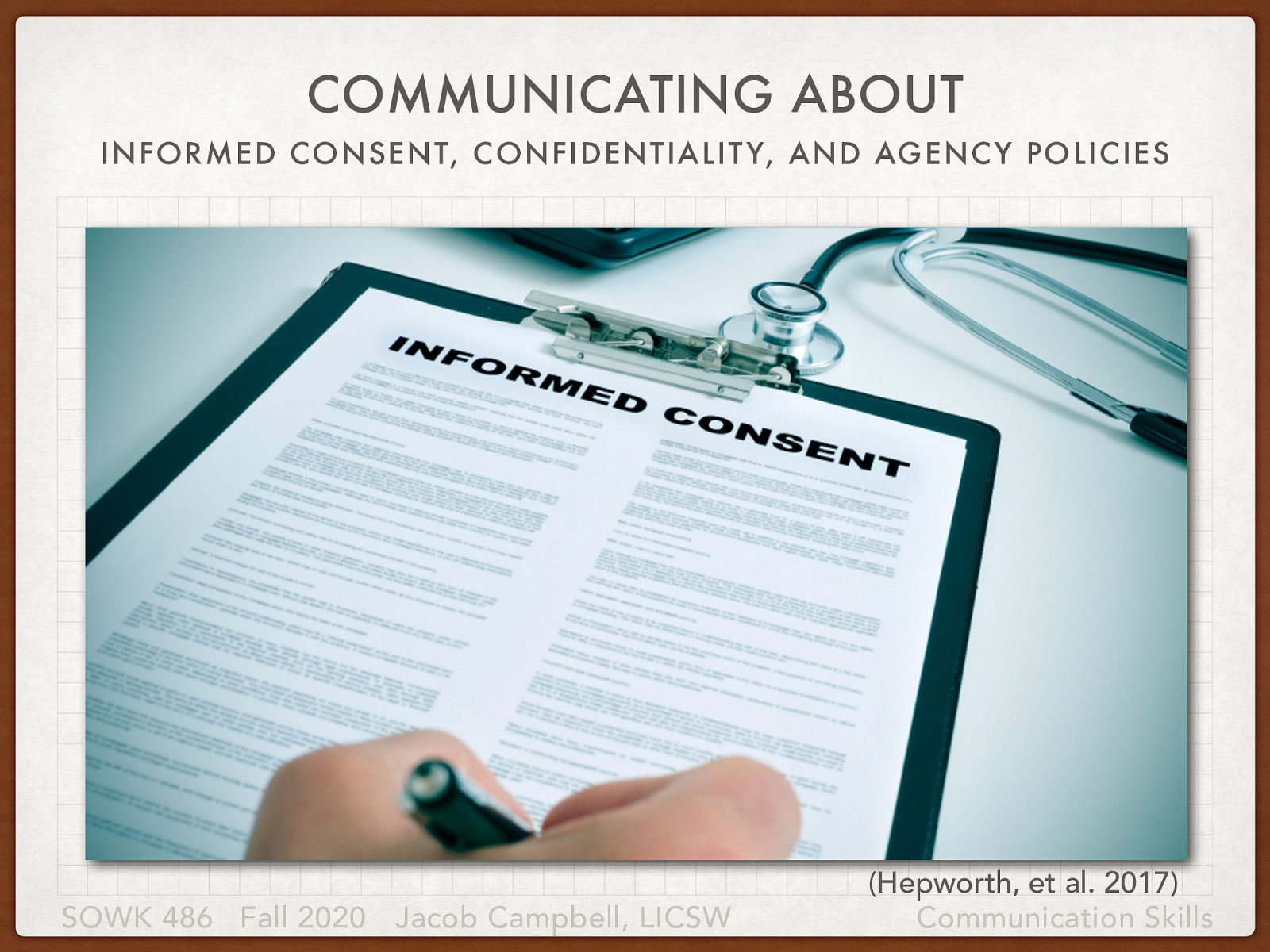
Communicating about Informed Consent, Confidentiality, and Agency Policies
- Importance of
- How to do
I want to let you know about a couple of important things. First, I want you know that the things you tell me are confidential. Do you know what that means?… There are some exceptions….
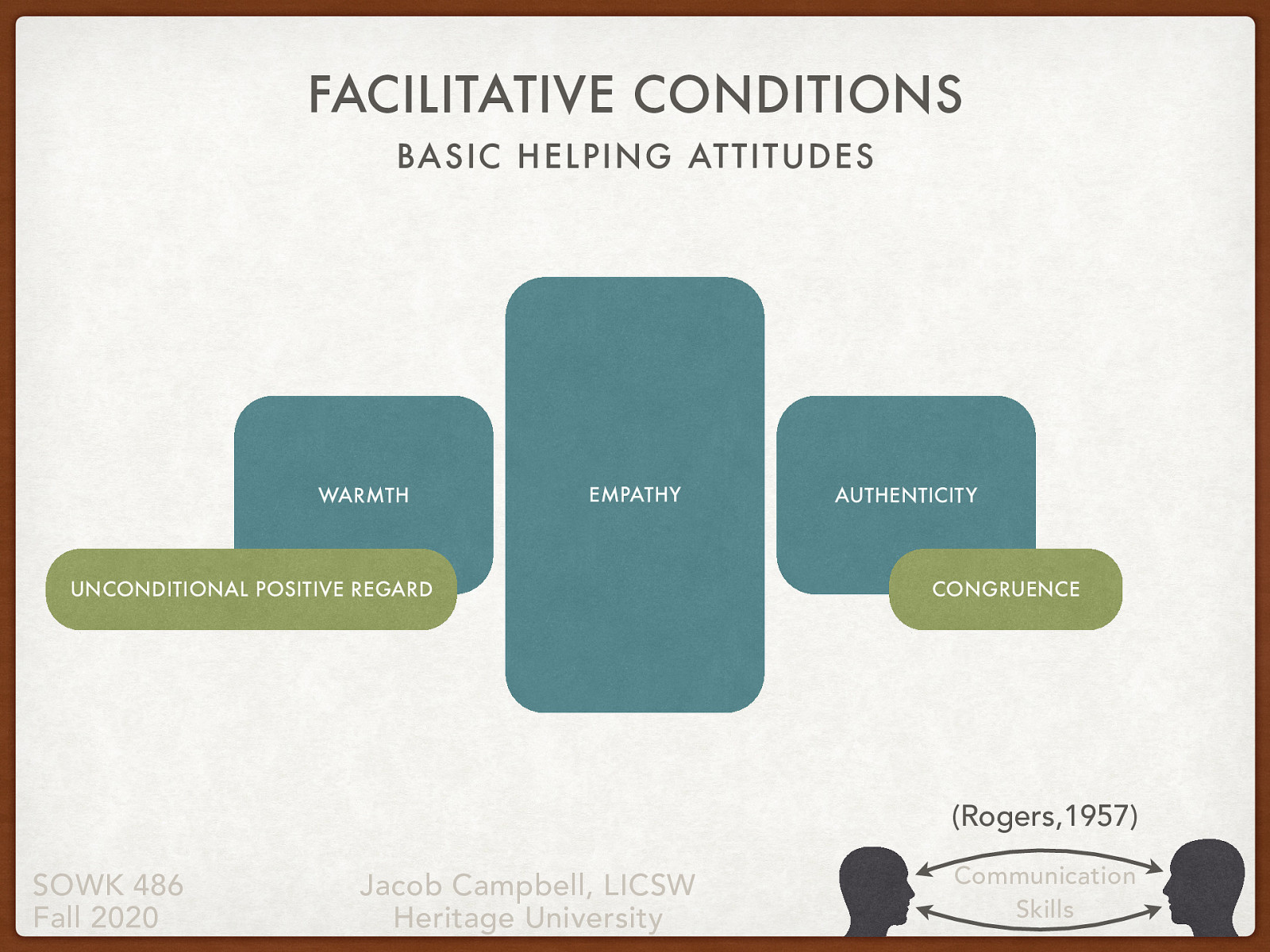
Facilitative Conditions
Carl Rodgers and person Center Counseling probably give the best and most focus on basic helping attitudes.
The facilitative conditions (or core conditions) in helping relationships were originally denoted by Carl Rogers (1957) as…
- Empathy
- Unconditional positive regard
- Congruence
Much of the current research describes these as:
Warmth
Authenticity
Empathy
Facilitative conditions are often thought to be the foundation-level skills that undergird many treatment models and help create a positive client–social worker relationship.
- Research has especially supported the correlation of empathy with positive social work outcomes.
The facilitative skills are particularly useful in treatment situations with voluntary clients.
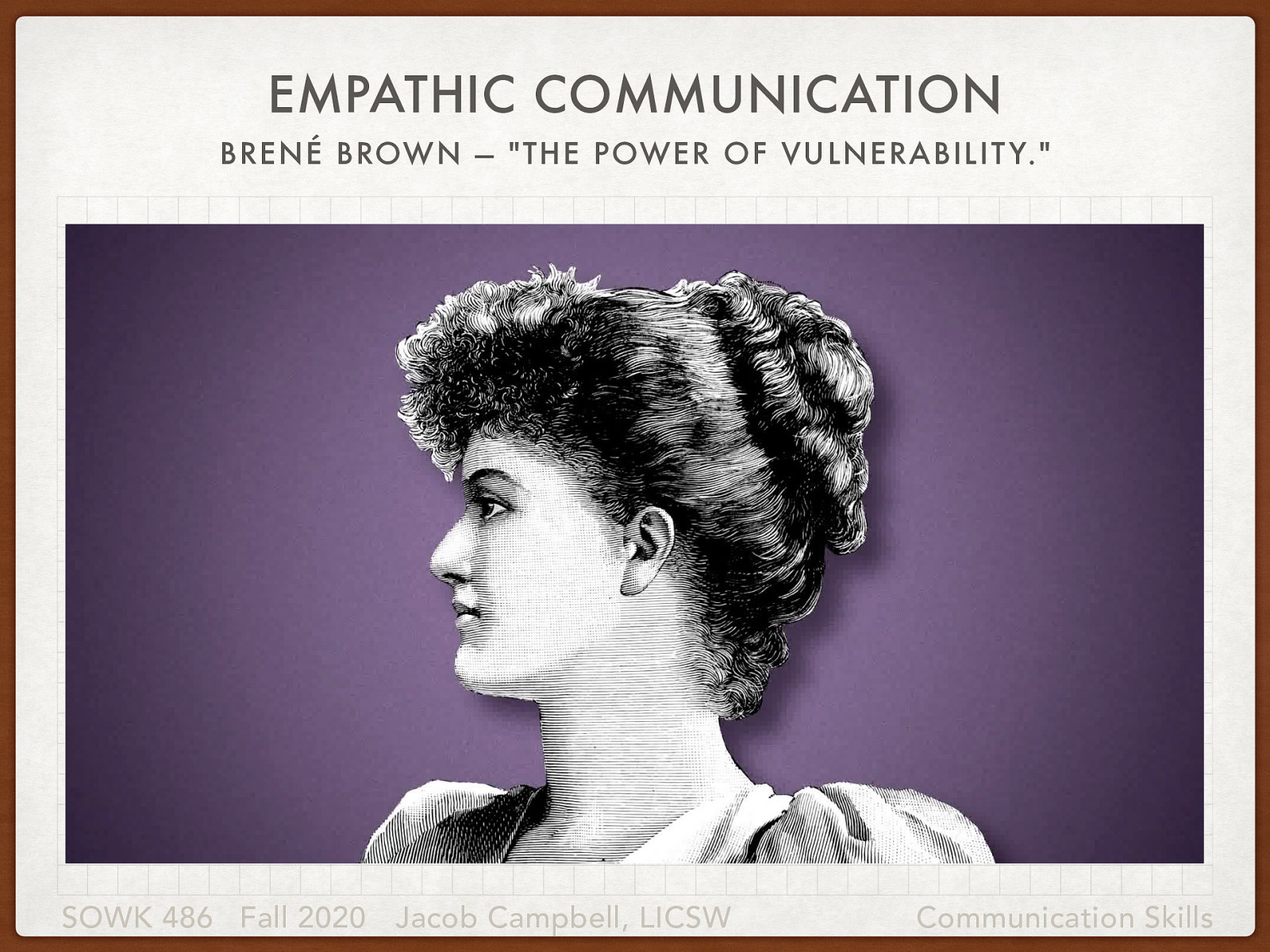
Empathic Communication (1 of 2)
The RSA. (2013, December 10). Brené Brown on Empathy. Brené Brown on Empathy. Retrieved from https://www.youtube.com/watch?v=1Evwgu369Jw
The following is a short video clip from a presentation that Brené Brown did called the “The Power of Vulnerability.”
[Activity] Watch the video clip.
[Discussion] What did you think of Theresa Wiseman (2007) concept of four parts to empathy. “Toward a holistic conceptualization of empathy for nursing practice.”
- Perspective taking and recognizing their perspective as truth
- Staying out of judgment
- Recognizing emotion in other people
- Communicating emotion with people
[Discussion] What do you think about this video?
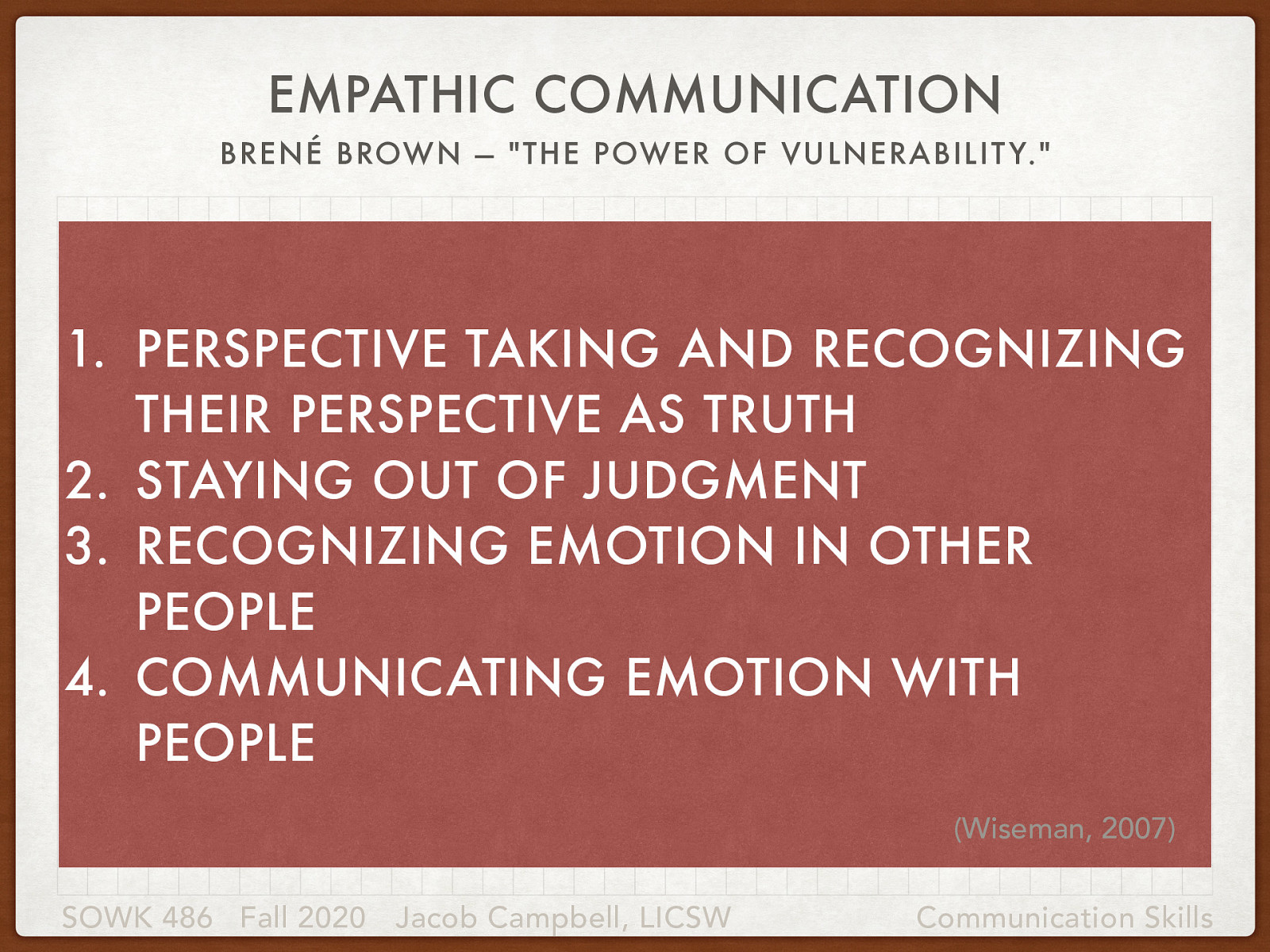
Empathic Communication (2 of 2)
To review, that is…
- Perspective taking and recognizing their perspective as truth
- Staying out of judgment
- Recognizing emotion in other people
- Communicating emotion with people
Wiseman, T. (2007). Toward a holistic conceptualization of empathy for nursing practice. Advances in Nursing Science, 30(3), E61–E72. https://doi.org/10.1097/01.ANS.0000286630.00011.e3
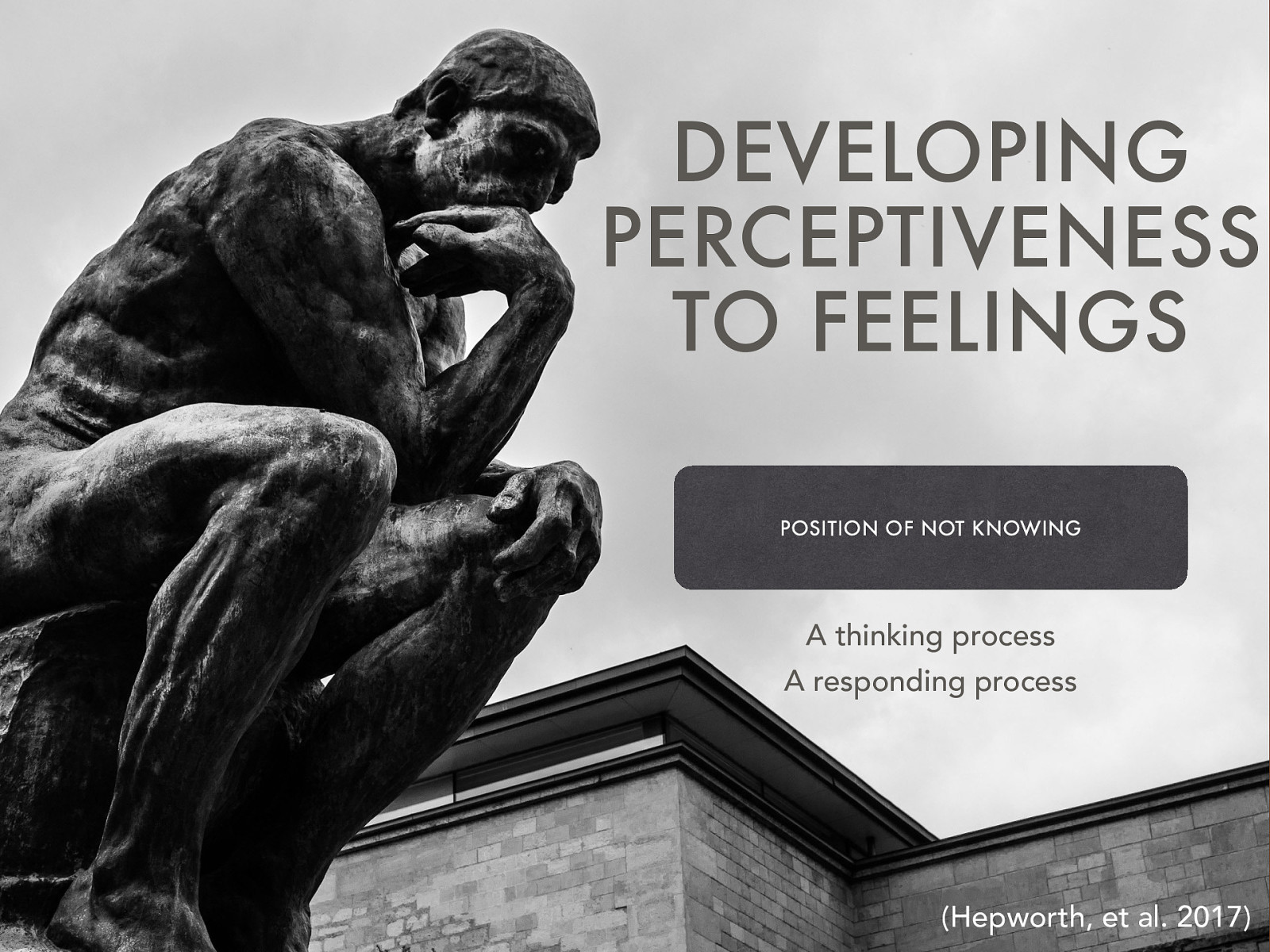
Developing Perceptiveness to Feelings
With empathy being such an important skill, we need to discuss how we can develop perceptiveness to feelings. As well we know that feelings or emotions exert a powerful influence on behavior and often play a central role in the problems of clients.
- To respond to the broad spectrum of emotions and feeling states presented by clients, the social worker must be fully aware of the diversity of human emotions.
- Position of not knowing…
- They also need to take a “not knowing” position of learning what emotional expression means for the particular client in front of them.
- It is important to realize that high-level empathic responding takes place in two phases:
- A thinking process
- A responding process
Applicants or voluntary clients often enter into the helping relationship with openness, hoping to explore both their concerns and their related feelings.
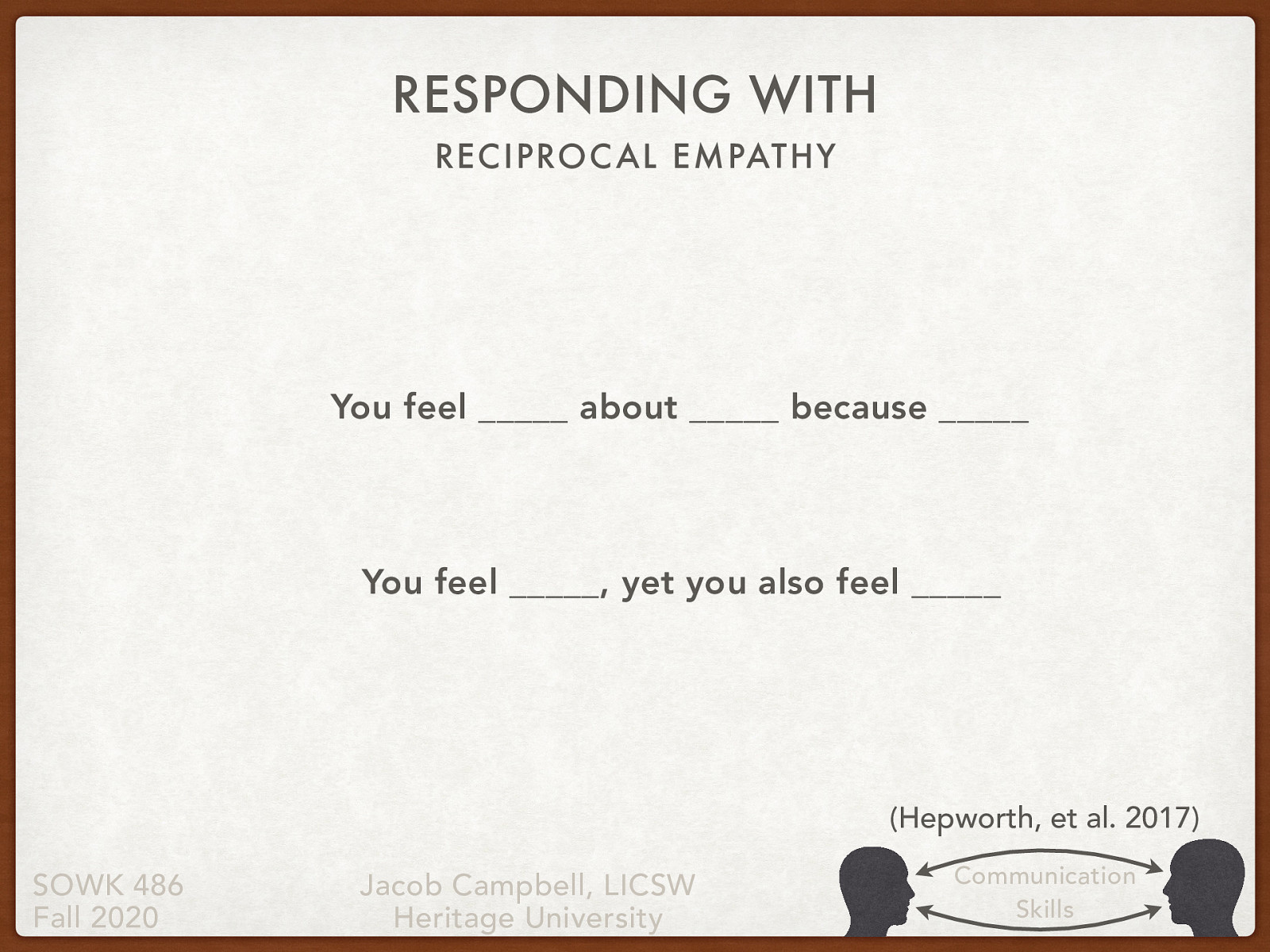
Responding with Reciprocal Empathy
You feel __ about __ because __ You feel __, yet you also feel __
[Partner Group Activity] With partner, take turns sharing respectively for about five minutes, about an experience that they experienced a emotional response (any emotion, happiness, sadness, excitement, nervousness, etc. - does not need to be an overly personal story.) The person not telling the story job is to draw out the details of the event and find opportunities to respond empathetically.
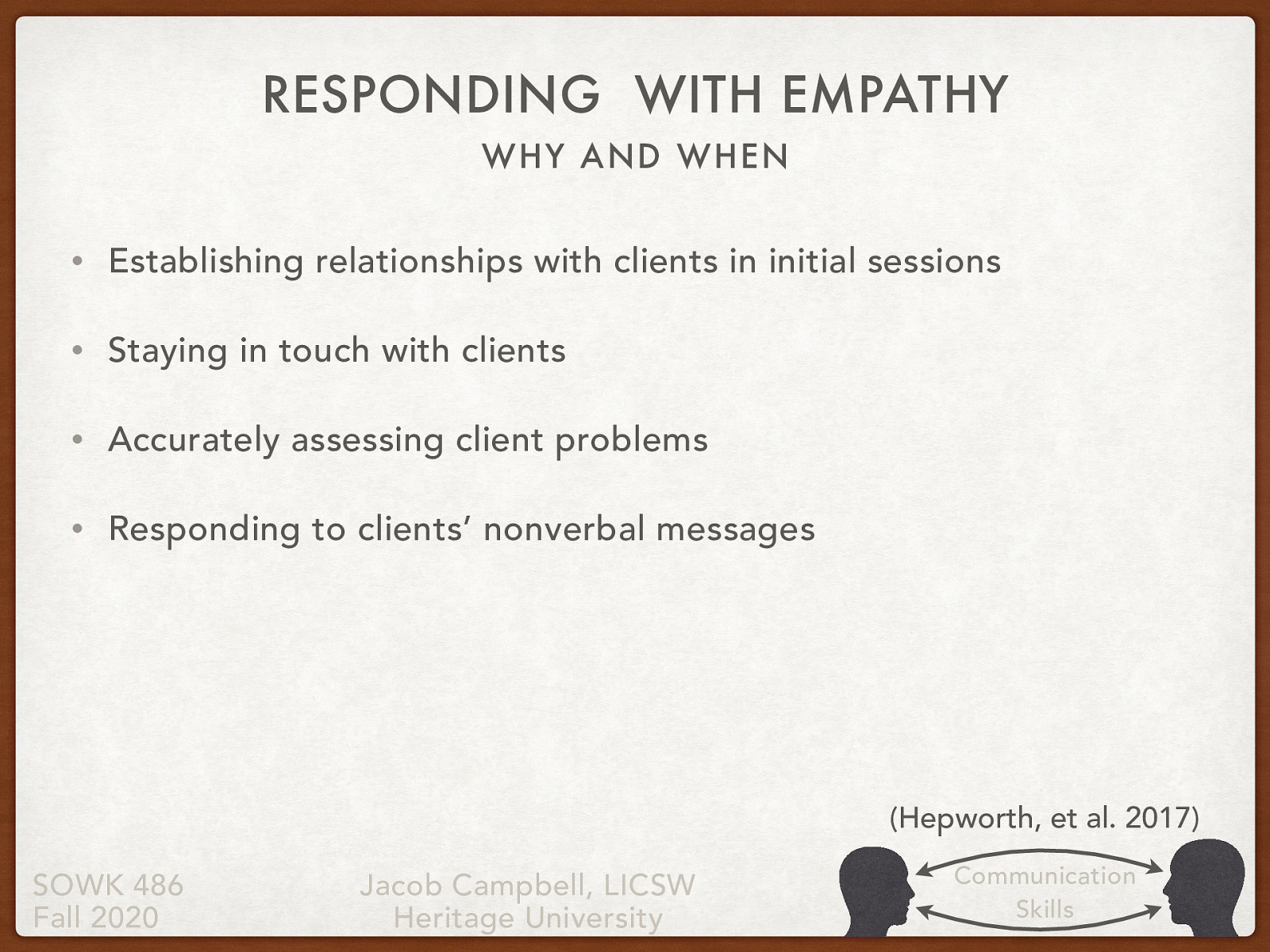
Responding with Empathy (1 of 2)
There are a number of ways in which social workers can employ reciprocal empathic responding:
- Establishing relationships with clients in initial sessions
- Staying in touch with clients
- Accurately assessing client problems
- Responding to clients’ nonverbal messages
—> Continues on next slide
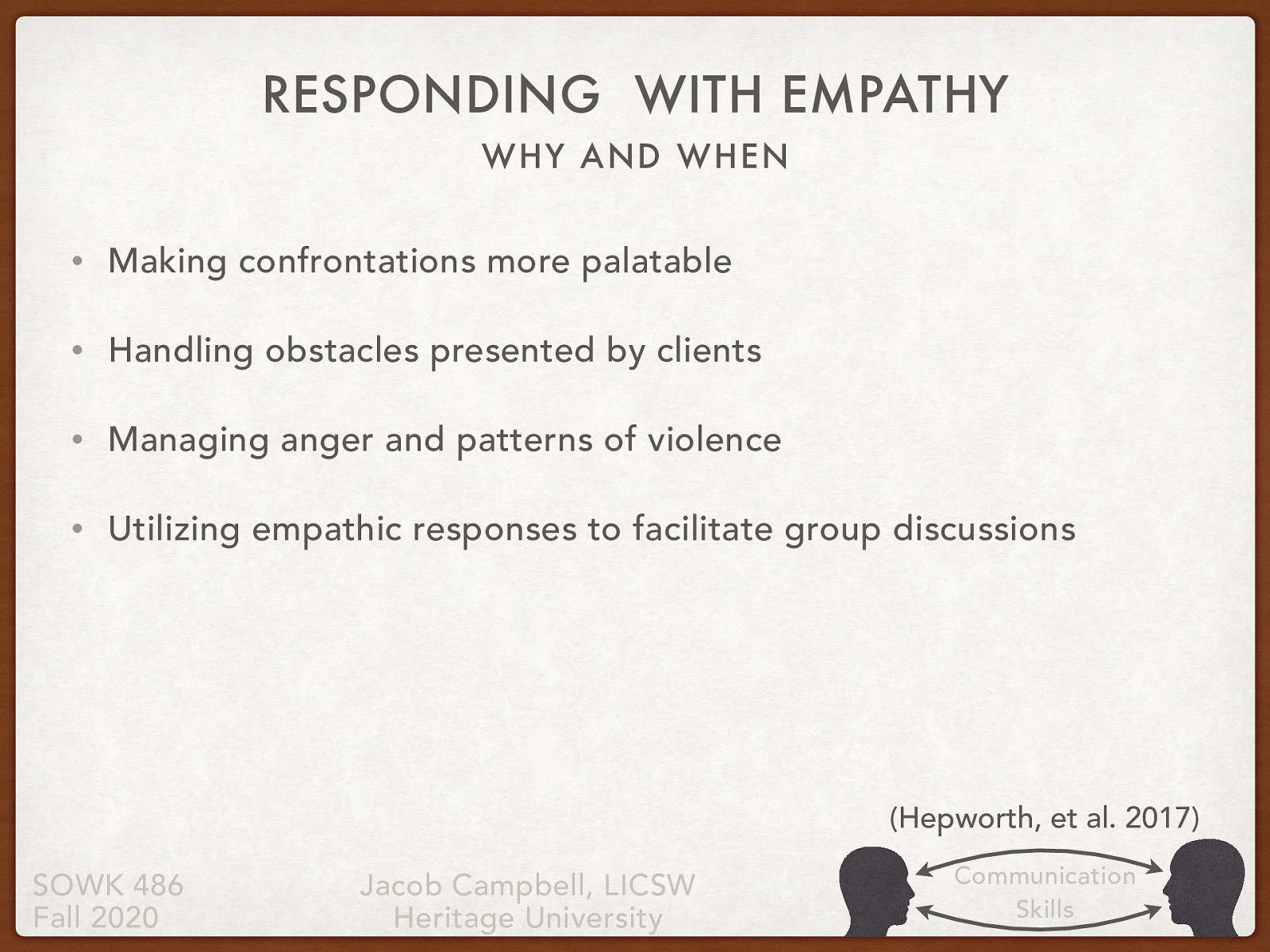
Responding with Empathy (2 of 2)
- Making confrontations more palatable
- Handling obstacles presented by clients
- Managing anger and patterns of violence
- Utilizing empathic responses to facilitate group discussions
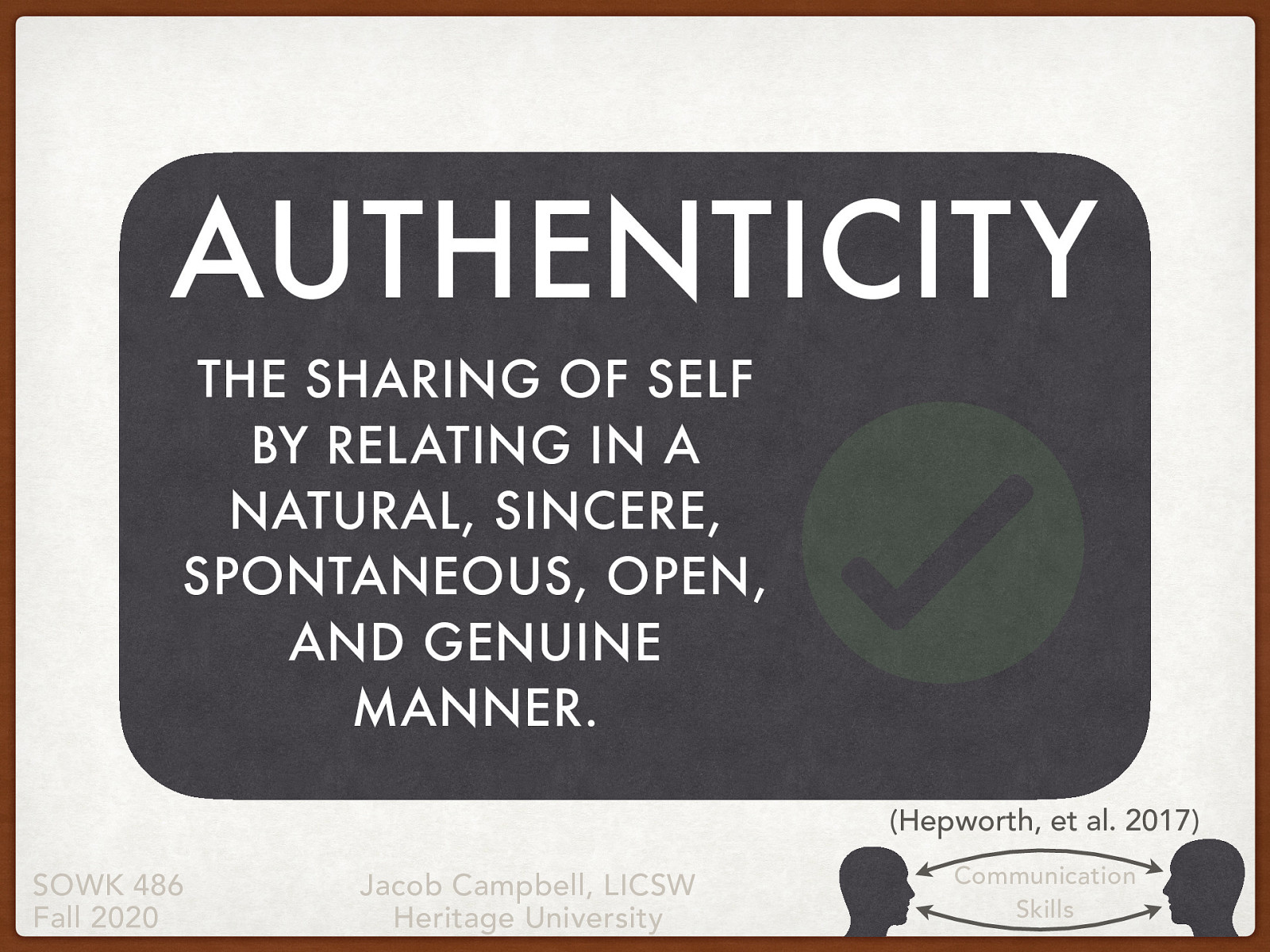
Authenticity
[Whole Class Activity] What is authenticity and why is it important?
Authenticity is defined as the sharing of self by relating in a natural, sincere, spontaneous, open, and genuine manner.
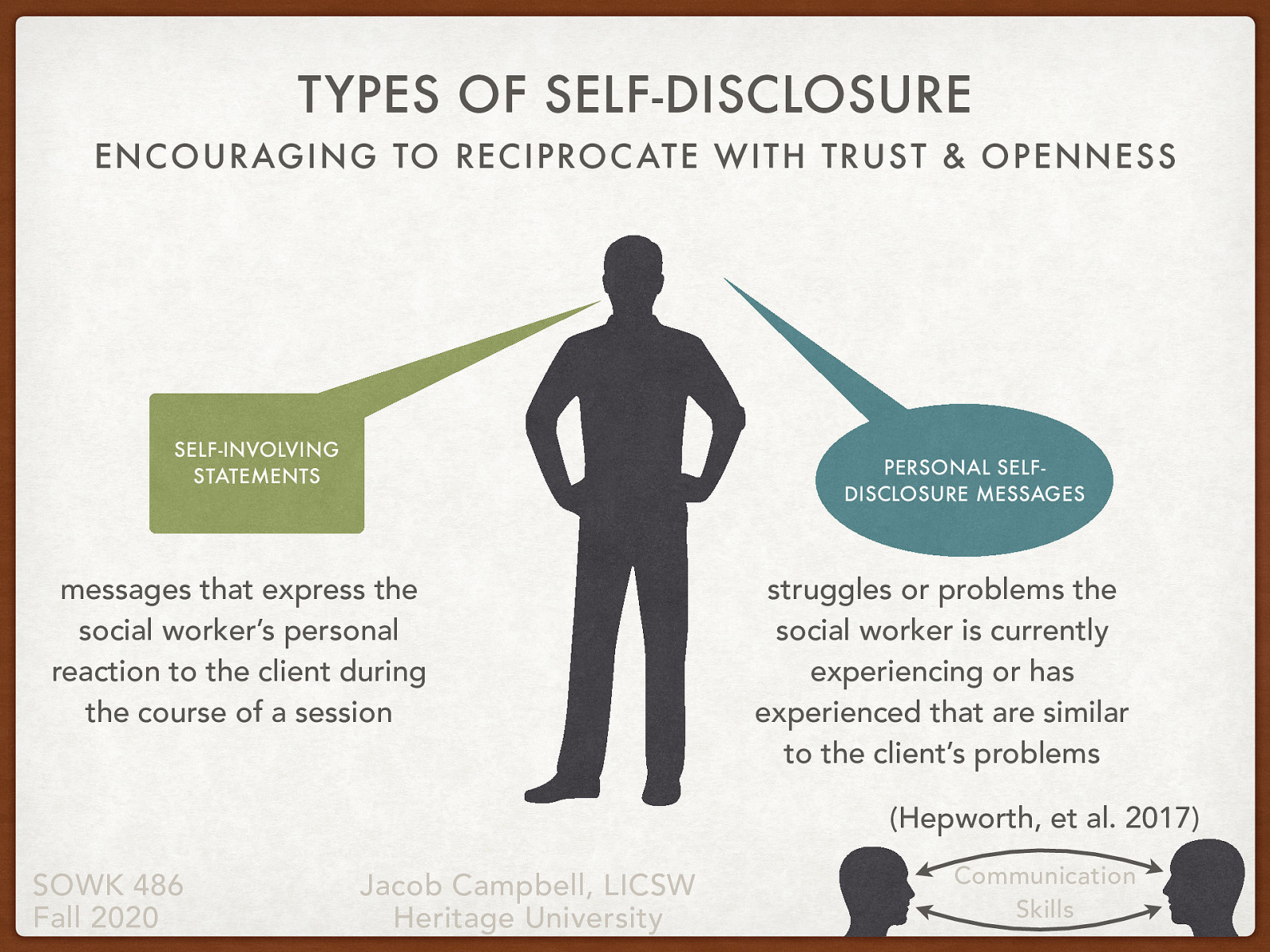
Types of Self-Disclosure: Encouraging to reciprocate with trust & openness
“Viewed from a therapeutic perspective, self-disclosure encourages clients to reciprocate with trust and openness. Lee (2014) has identified two types of self-disclosure: self-involving statements and personal self-disclosure” (Hepworth, et al., 2017)
- Self-involving statements include messages that express the social worker’s personal reaction to the client during the course of a session.
- Personal self-disclosure messages, by contrast, center on struggles or problems the social worker is currently experiencing or has experienced that are similar to the client’s problems
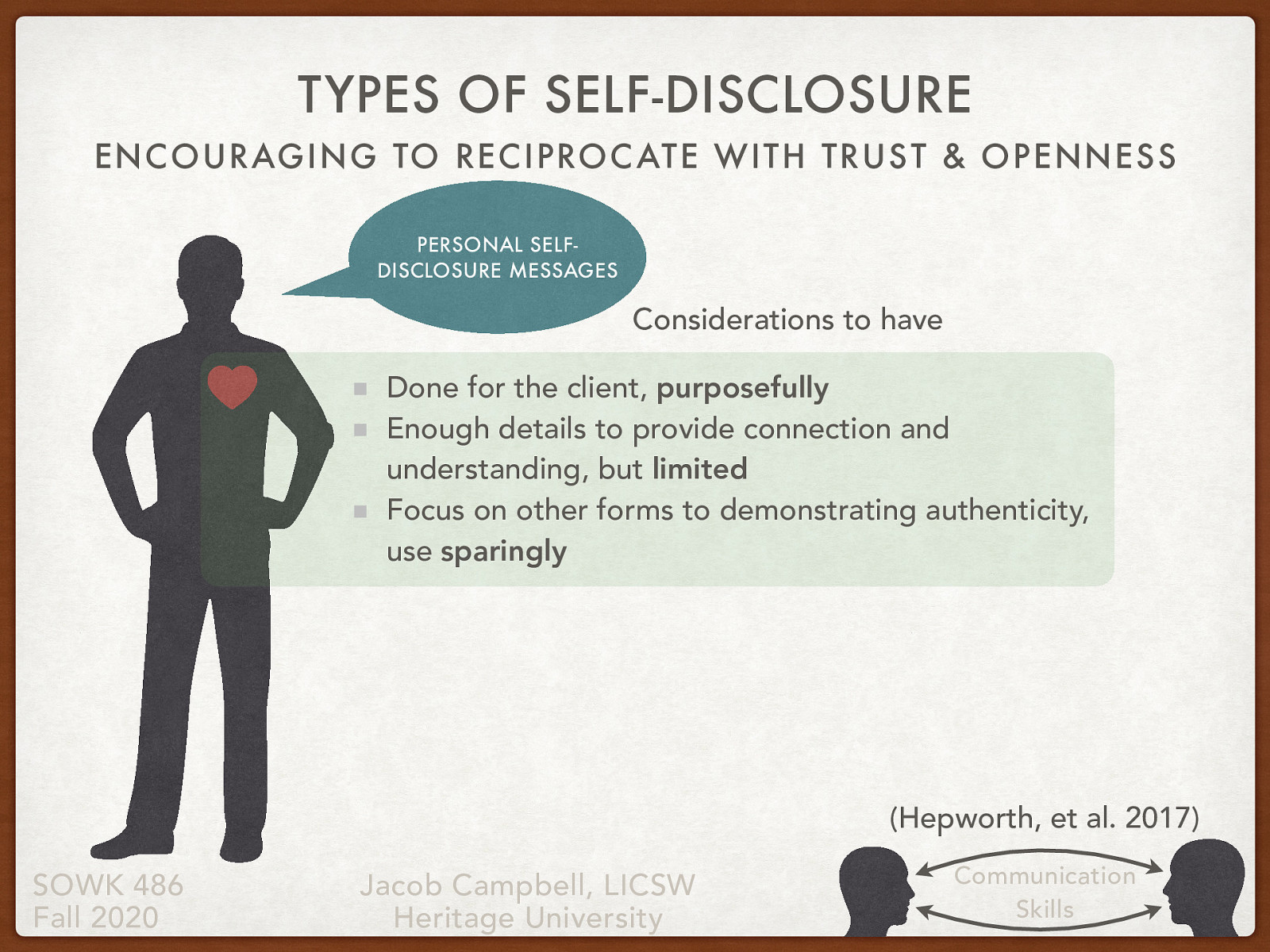
Personal self-disclosure messages
The use of self-disclosure can be a meaningful and useful tool that we use as social workers. I also want to provide caution to you. First, let me tell you about my experience and then a couple of things I have found that you should consider.
- Tell story of my dad
- Tell story of starting our in social work and self-disclosure
- Talk about the three things that are important.
- Done for the client, purposefully
- Enough details to provide connection and understanding, but limited
- Focus on other forms to demonstrating authenticity, use sparingly
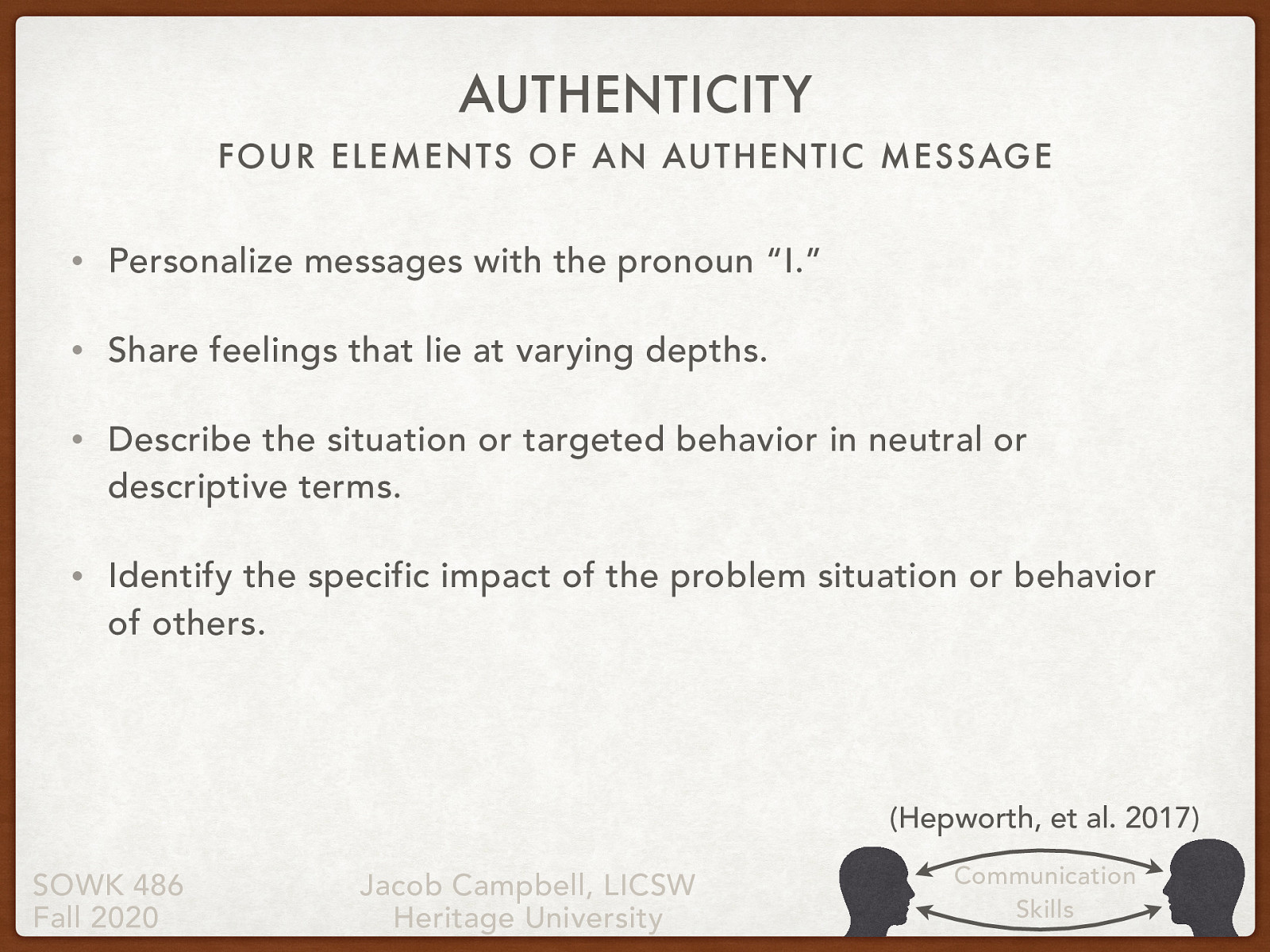
Authenticity: Four Elements of an Authentic Message
As social workers practice authentic responding and teach clients to respond authentically in their encounters with others, they should keep in mind the following guidelines related to the four elements of an authentic message:
- Personalize messages with the pronoun “I.”
- Share feelings that lie at varying depths.
- Describe the situation or targeted behavior in neutral or descriptive terms.
- Identify the specific impact of the problem situation or behavior of others.
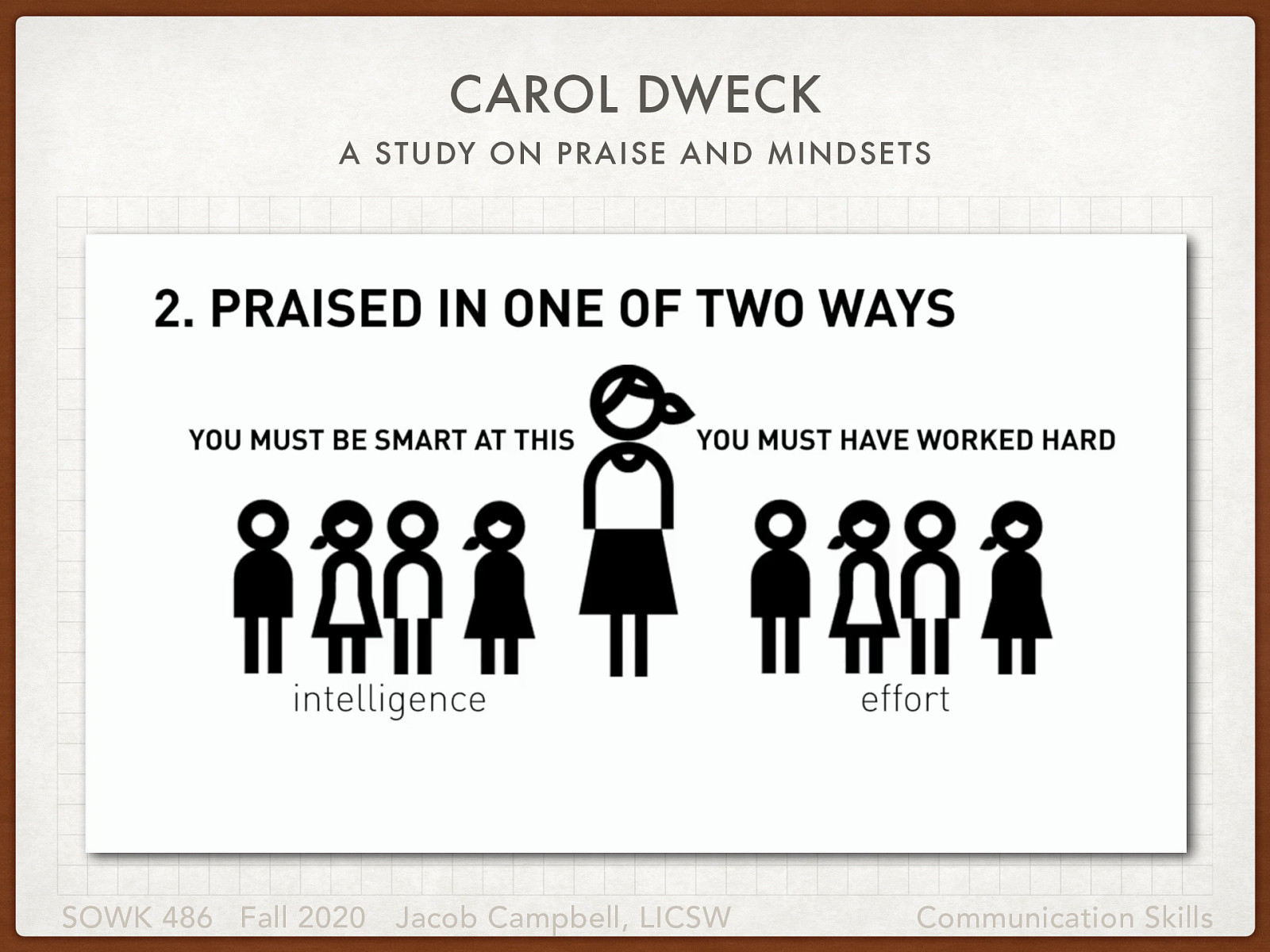
Carol Dweck - A Study on Praise and Mindsets
Ragan, T. (2014 Jan 30) Carol Dweck - A study on praise and mindsets [Video File]. Retrieved from https://youtu.be/NWv1VdDeoRY.
[Whole Class Activity] Watch the video.
[Whole Class Activity] Discuss:
- How does this impact us as social workers
- How do we give specific praise
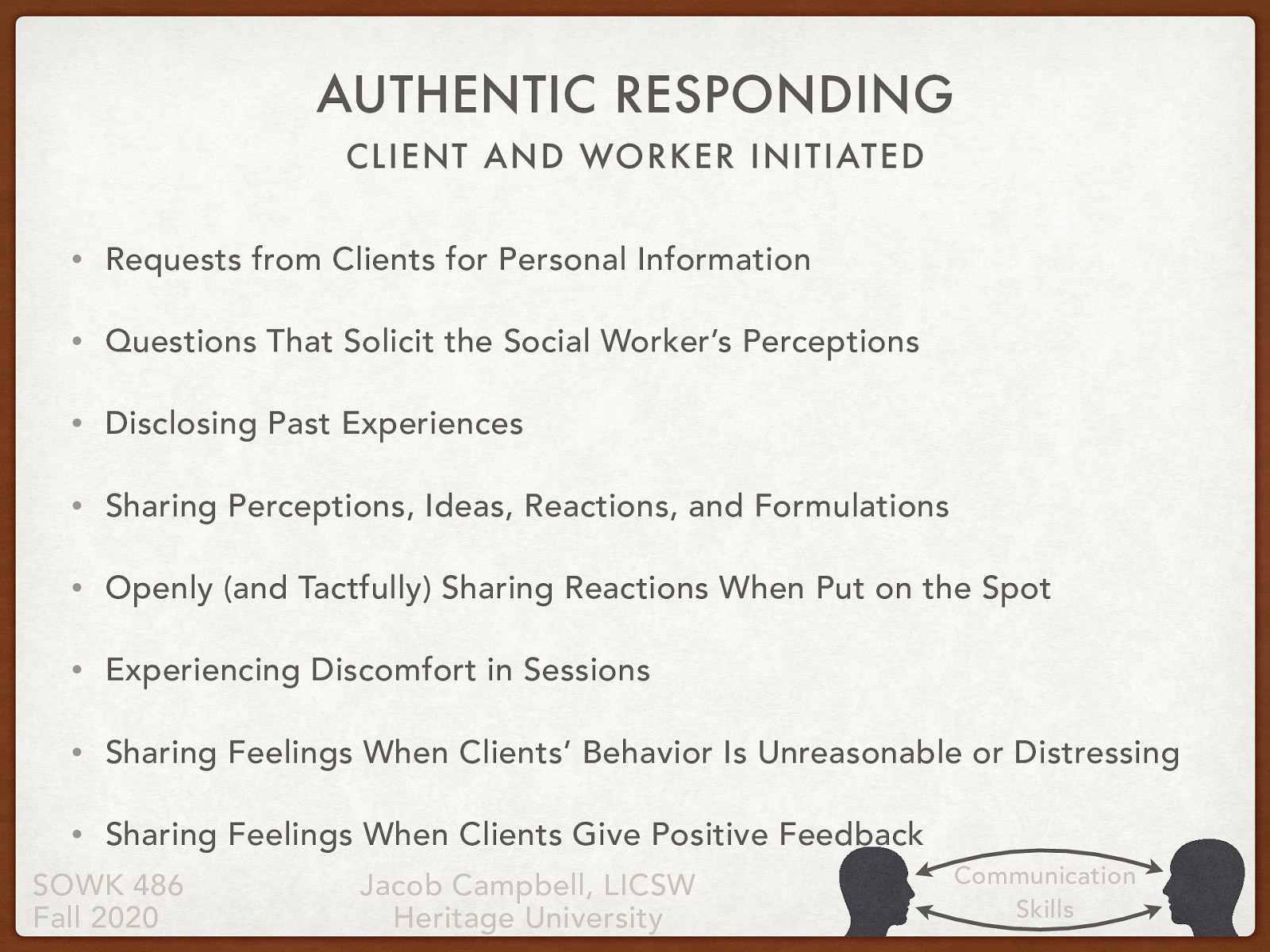
Authentic Responding
As social workers, we sometimes have to authentically respond when there are requests made by the client or when we believe it is for the best interest of the client.
Client Initiated
- Requests from Clients for Personal Information
- Questions That Solicit the Social Worker’s Perceptions
Worker Initiated
- Disclosing Past Experiences
- Sharing Perceptions, Ideas, Reactions, and Formulations
- Openly (and Tactfully) Sharing Reactions When Put on the Spot
- Experiencing Discomfort in Sessions
- Sharing Feelings When Clients’ Behavior Is Unreasonable or Distressing
- Sharing Feelings When Clients Give Positive Feedback
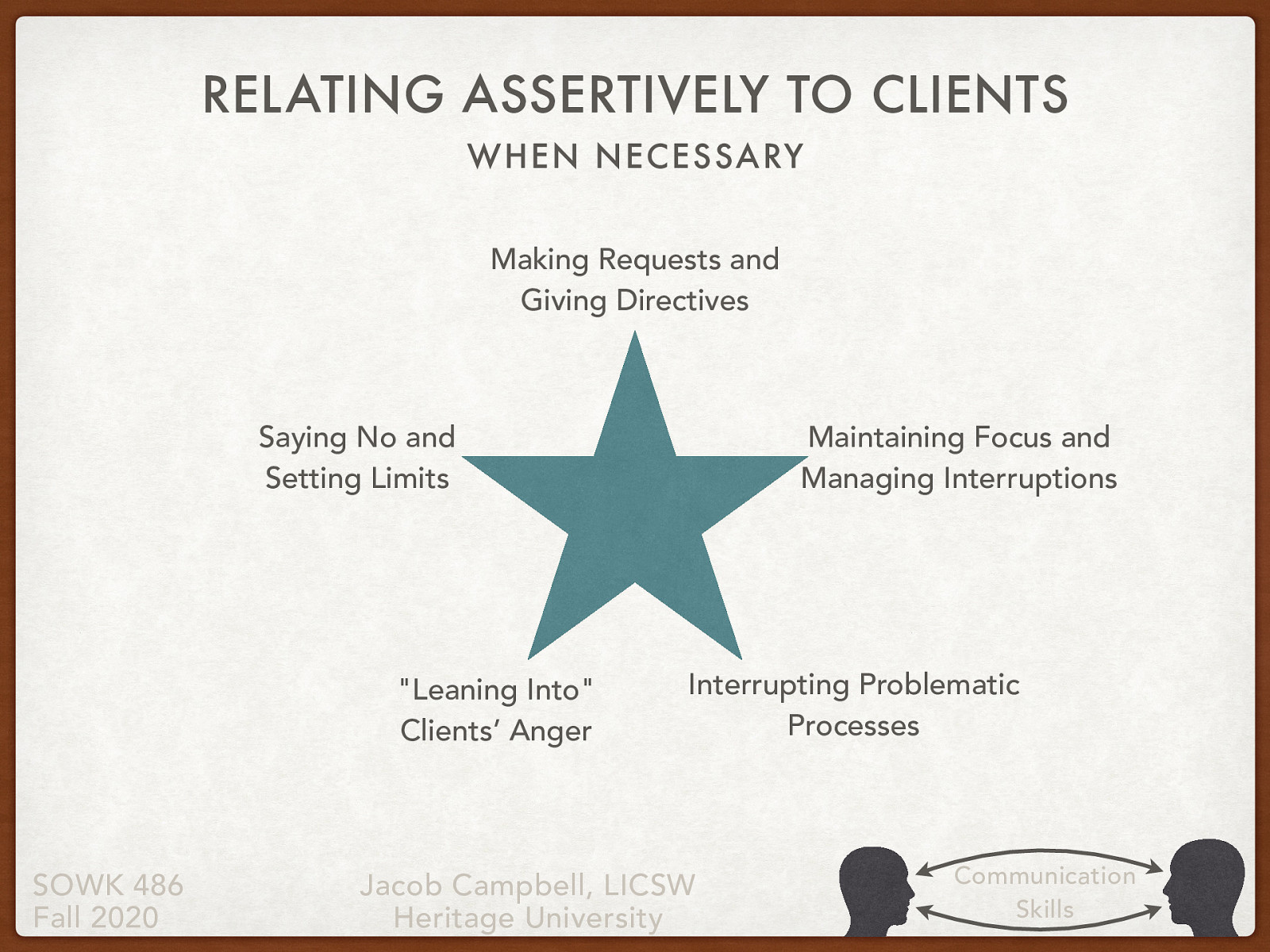
Relating Assertively to Clients: When Necessary
“Another aspect of relating authentically entails relating assertively to clients when a situation warrants such behavior.”
- Making Requests and Giving Directives: Work on problem solving during session and skill building.
- Maintaining Focus and Managing Interruptions: Keeping focus
- Interrupting Problematic Processes: When things aren’t going well.
- “Leaning Into” Clients’ Anger: Managing angry responses
- Saying No and Setting Limits: Saying no.
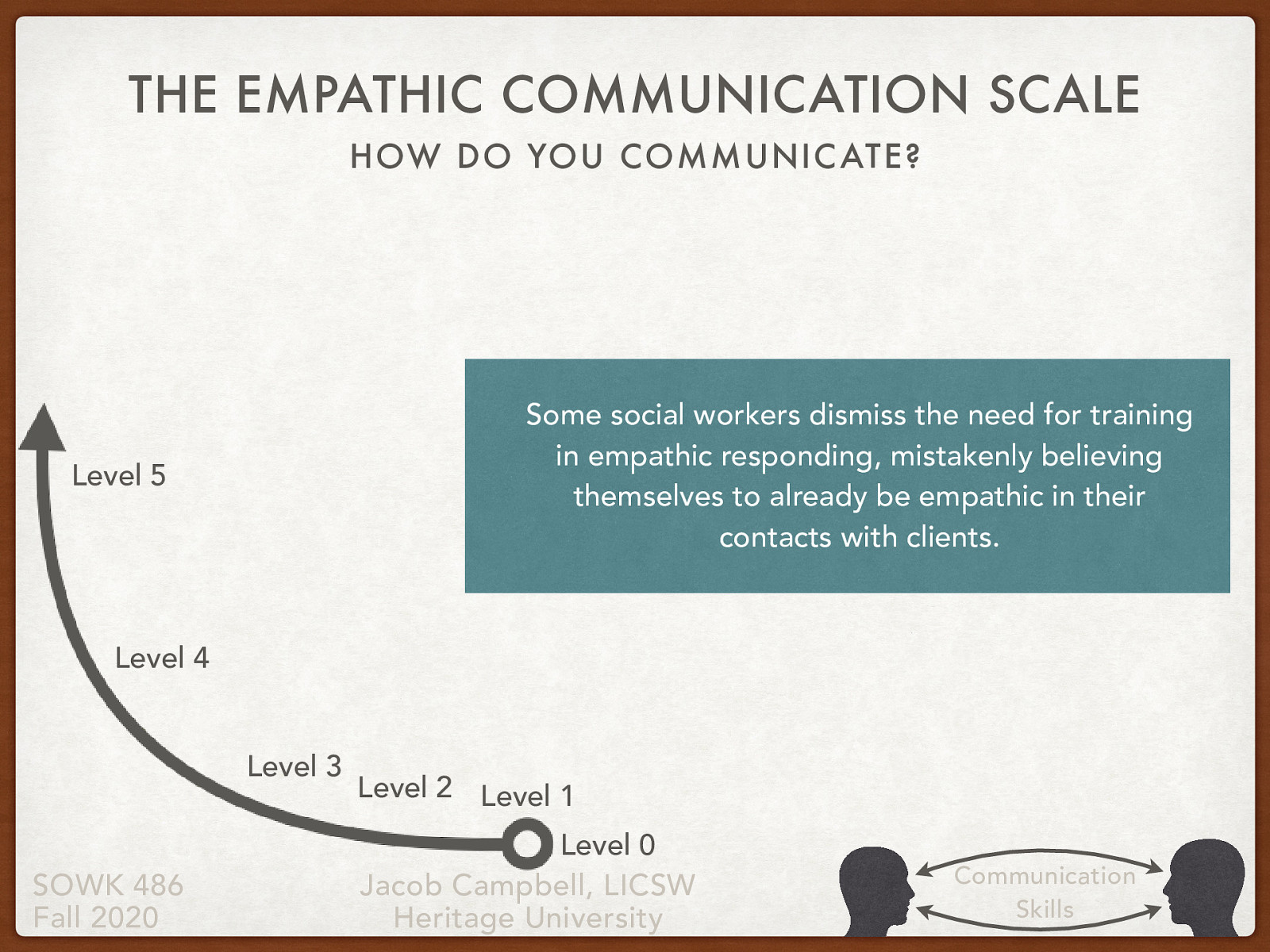
The Empathic Communication Scale (1 of 8)
Empathic responding is a fundamental yet complex skill that requires systematic practice and extensive effort to achieve competency.
- Some social workers dismiss the need for training in empathic responding, mistakenly believing themselves to already be empathic in their contacts with clients.
We can all improve our own level of empathetic responding. I would encourage you to consider where you really are at in regarding to your ability to empathetically respond.
There are six levels on the empathic communication scale:
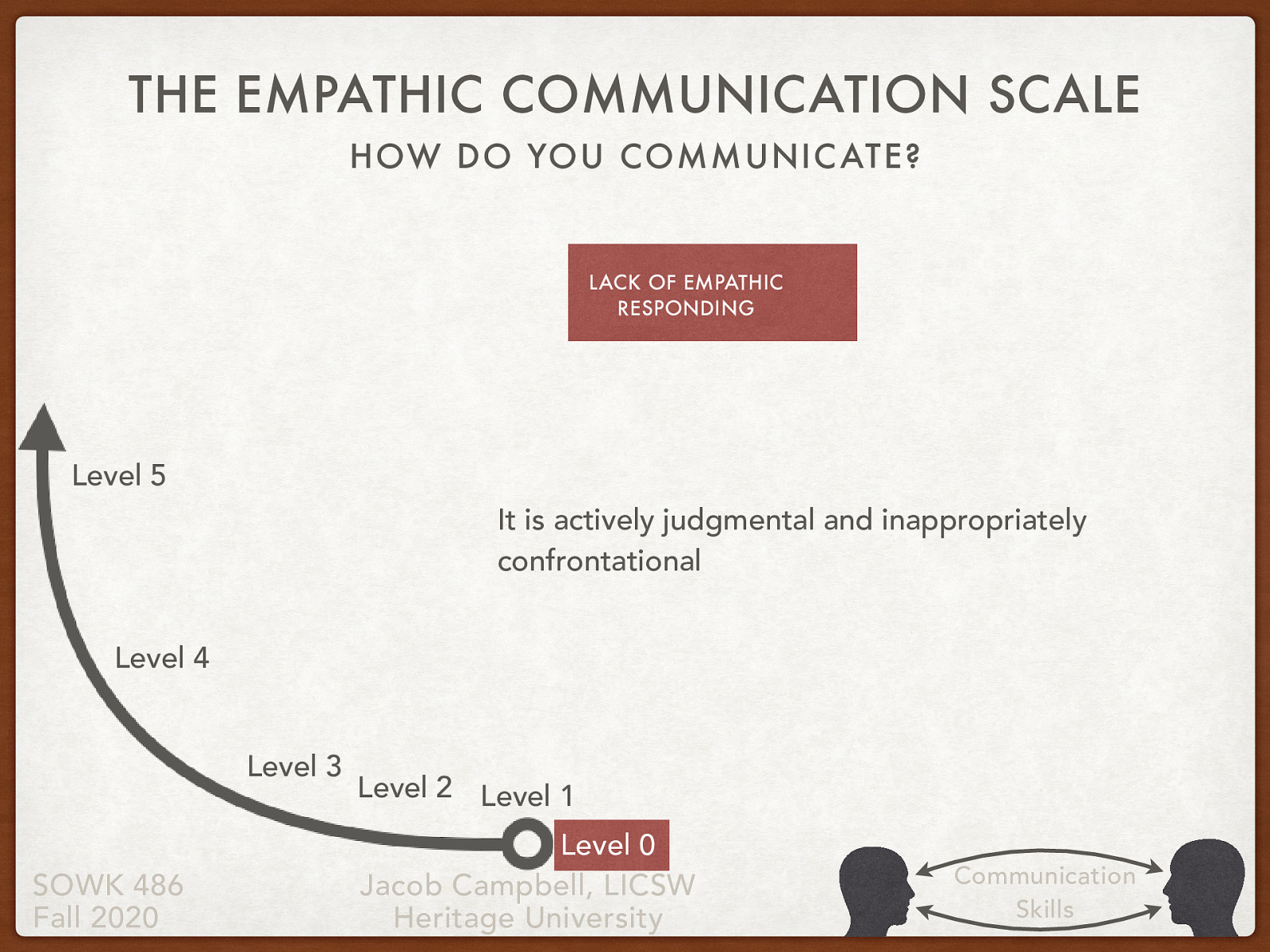
The Empathic Communication Scale (2 of 8)
Level 0: Lack of empathic responding
It is actively judgmental and inappropriately confrontational
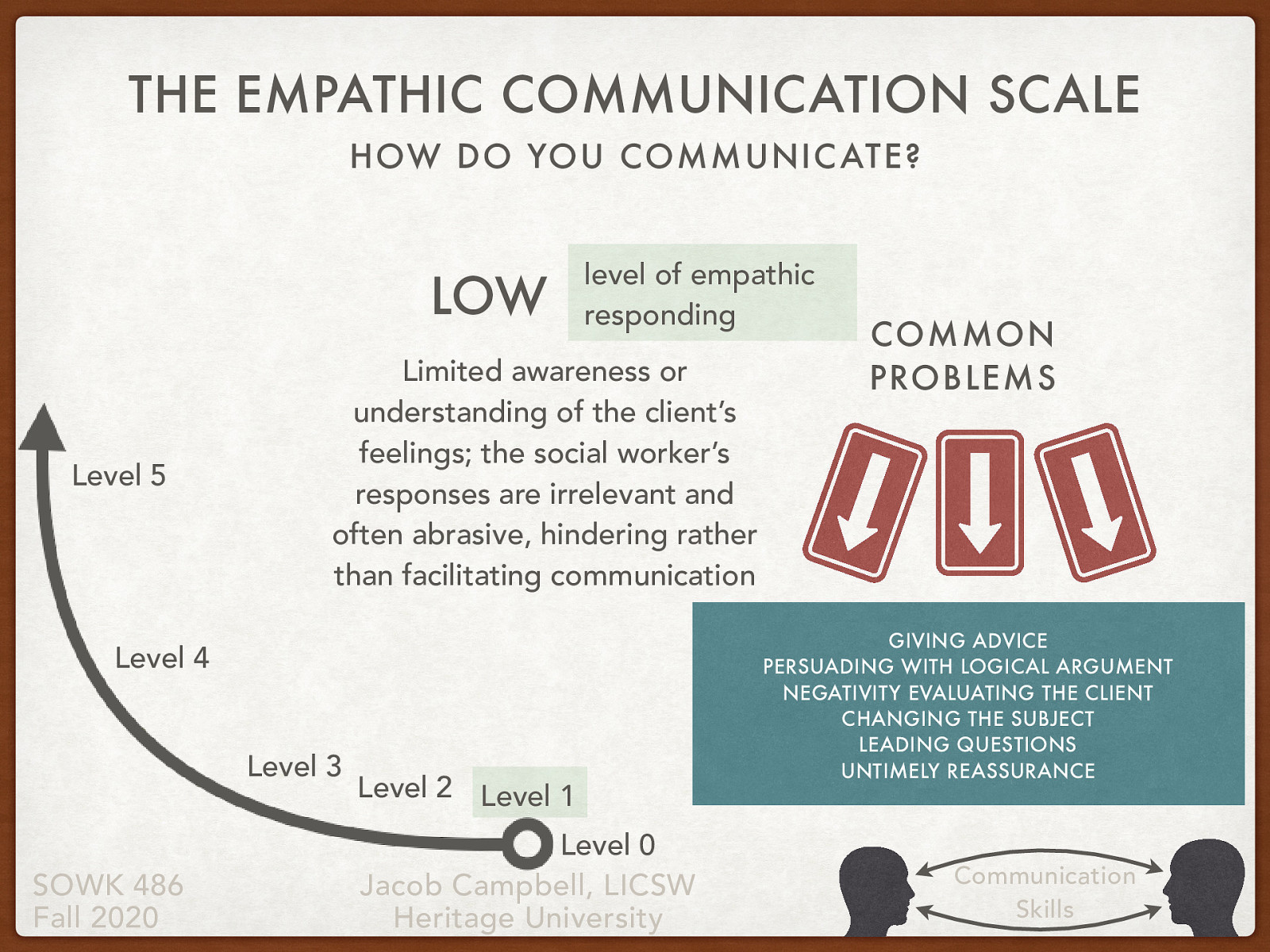
The Empathic Communication Scale (3 of 8)
Level 1: Low level of empathic responding
Limited awareness or understanding of the client’s feelings; the social worker’s responses are irrelevant and often abrasive, hindering rather than facilitating communication
Common problems related to level one are…
- Giving advice
- Persuading with logical argument
- Negativity evaluating the client
- Changing the subject
- Leading questions
- Untimely reassurance
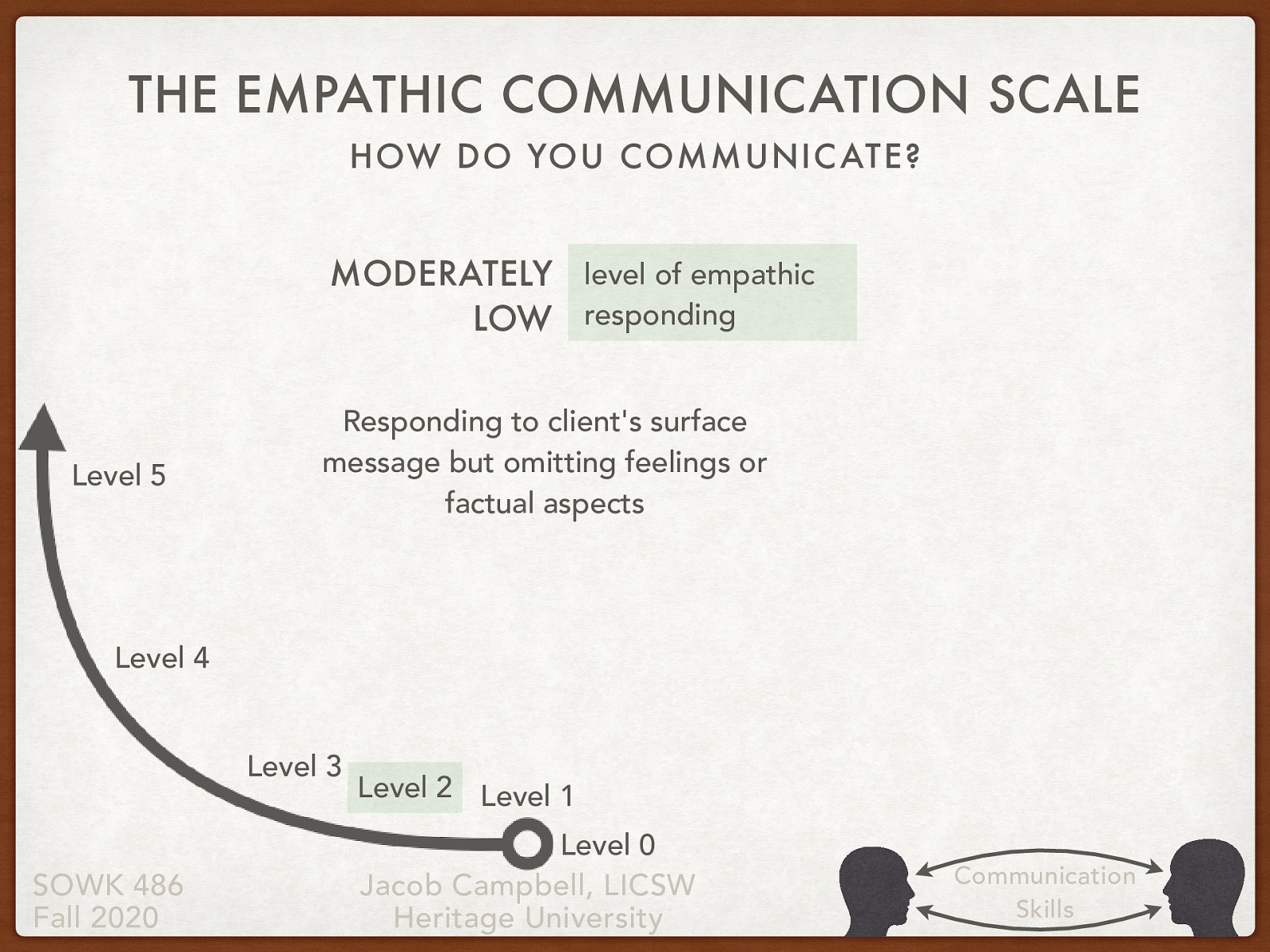
The Empathic Communication Scale (4 of 8)
Level 2: Moderately low level of empathic responding
Responding to client’s surface message but omitting feelings or factual aspects
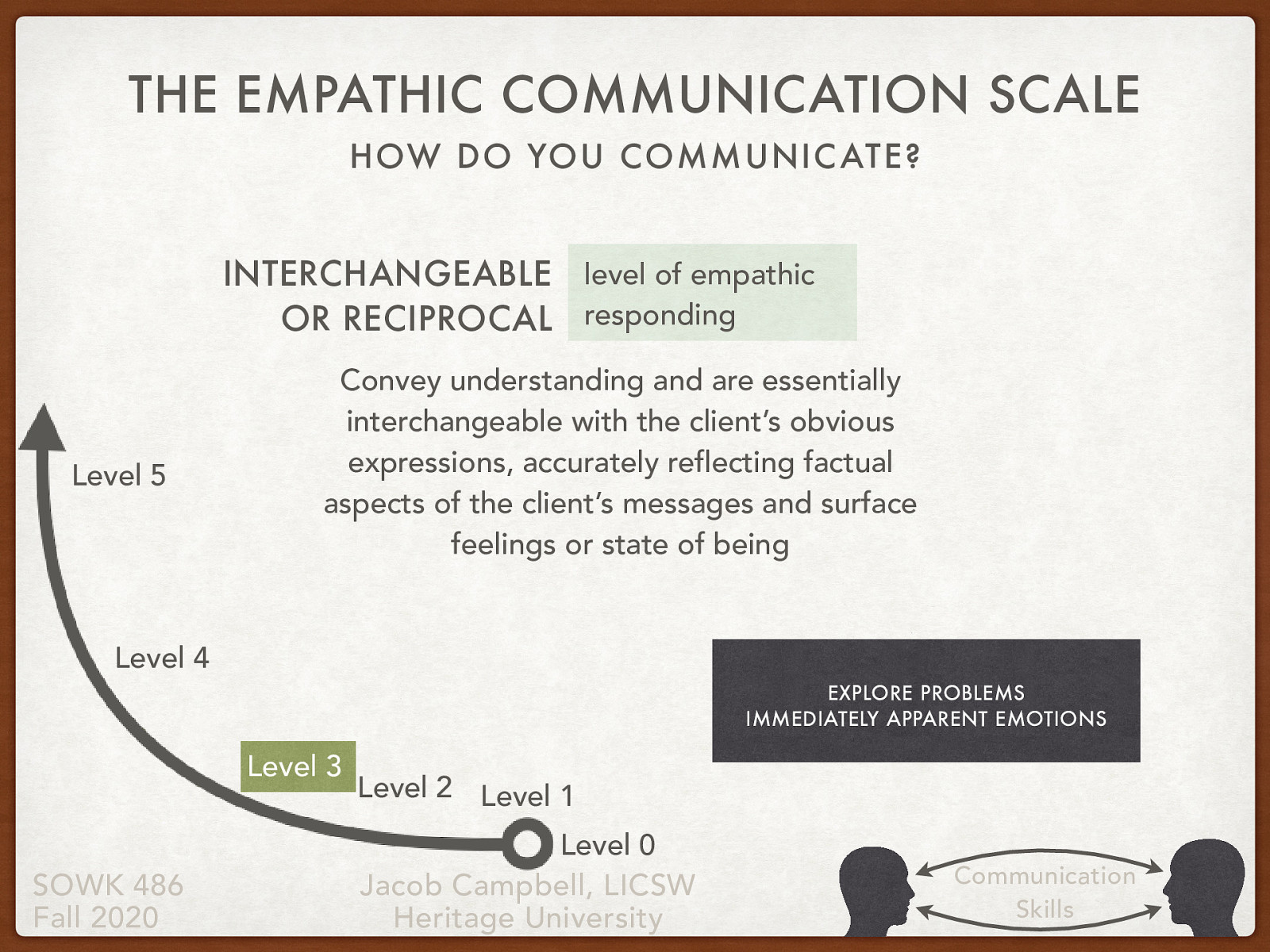
The Empathic Communication Scale (5 of 8)
Level 3: Interchangeable or reciprocal level of empathic responding
Ok therapeutic level of empathetic communication…
convey understanding and are essentially interchangeable with the client’s obvious expressions, accurately reflecting factual aspects of the client’s messages and surface feelings or state of being
- Explore problems: Can be used for further exploration of problem focused responses of the client
- Immediately apparent emotions: responses such as these express accurately the immediately apparent emotions in the client’s message
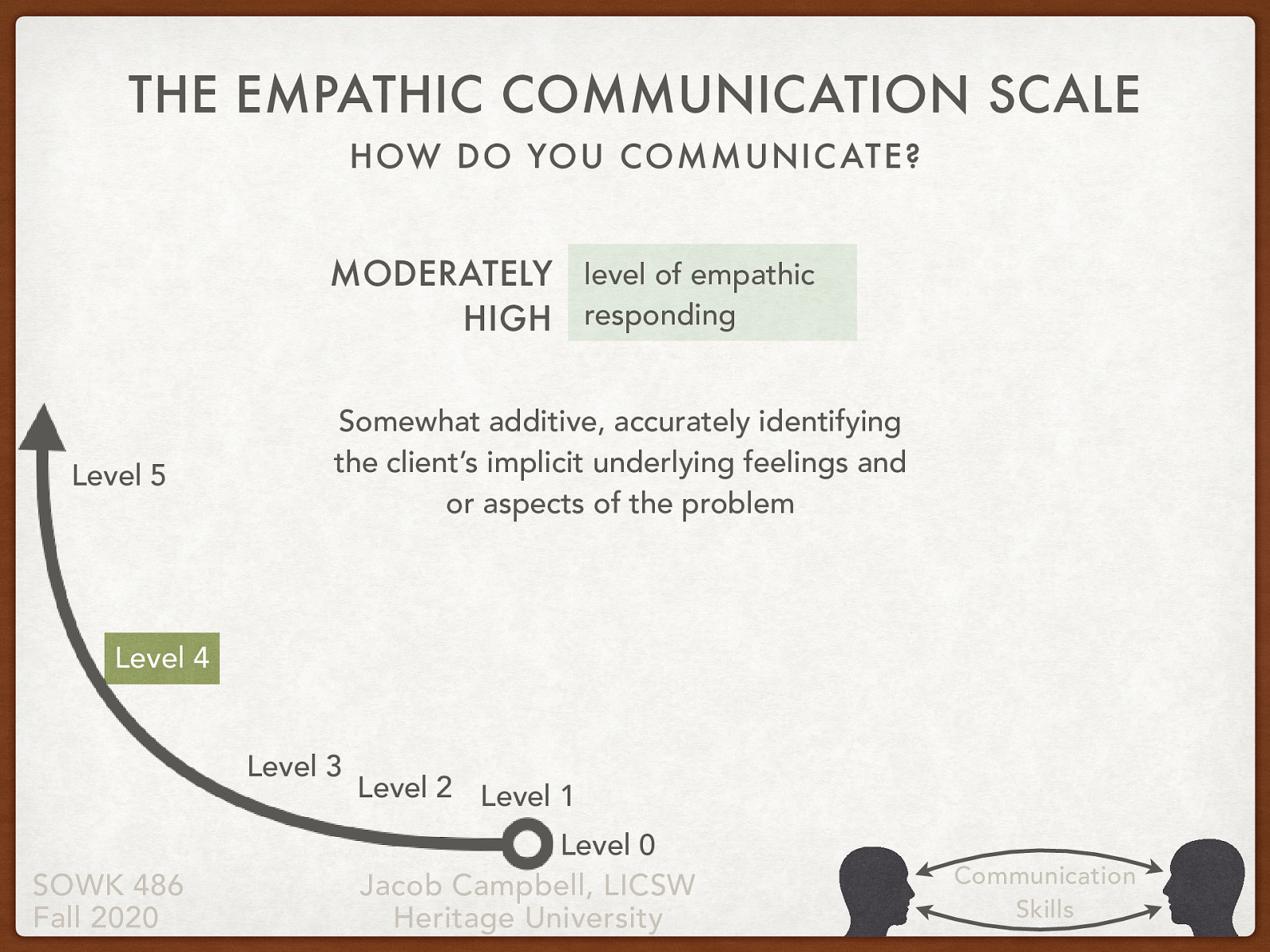
The Empathic Communication Scale (6 of 8)
Level 4: Moderately high level of empathic responding
Somewhat additive, accurately identifying the client’s implicit underlying feelings and/or aspects of the problem
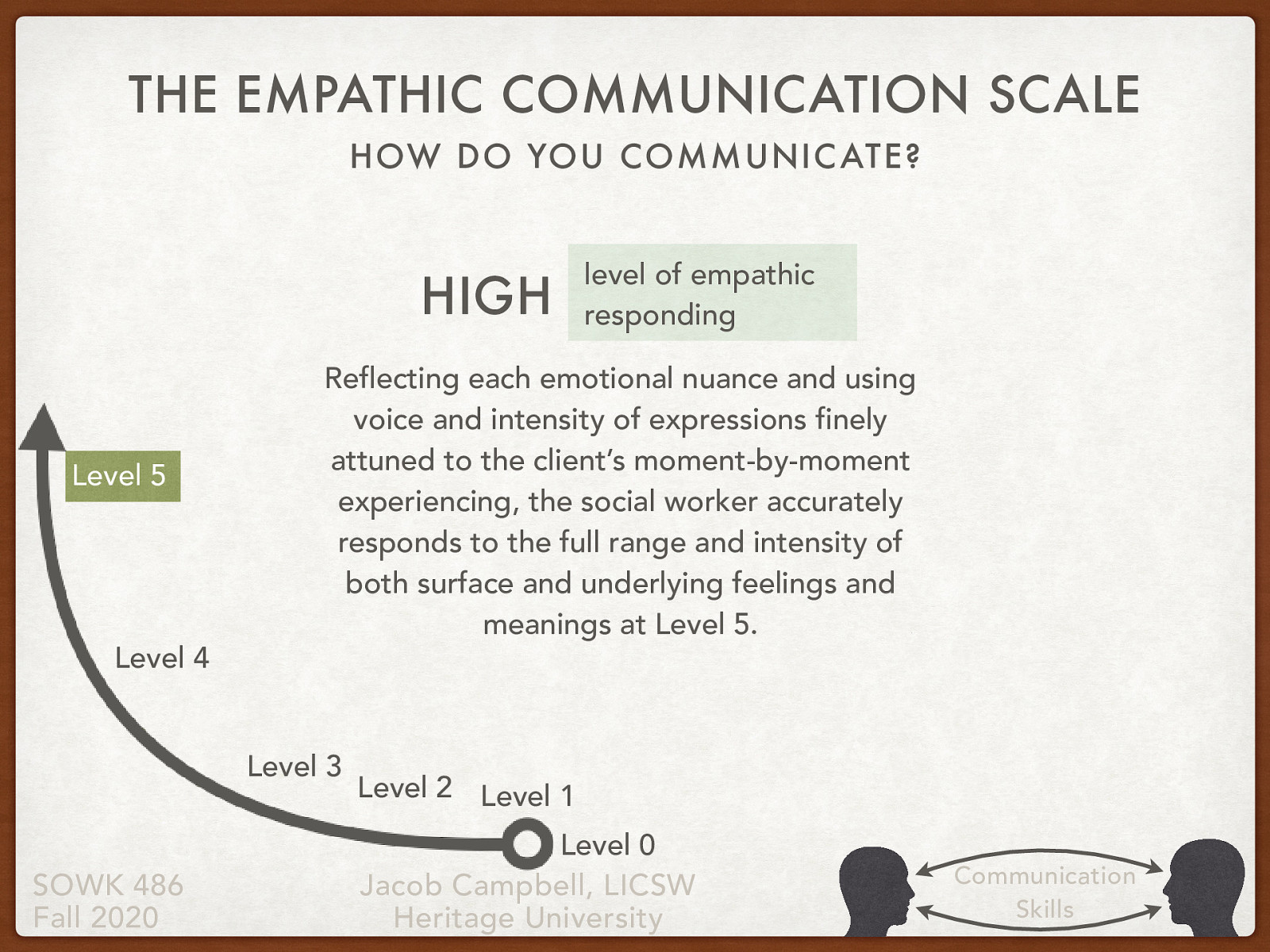
The Empathic Communication Scale (7 of 8)
Level 5: High level of empathic responding
Reflecting each emotional nuance and using voice and intensity of expressions finely attuned to the client’s moment-by-moment experiencing, the social worker accurately responds to the full range and intensity of both surface and underlying feelings and meanings at Level 5.
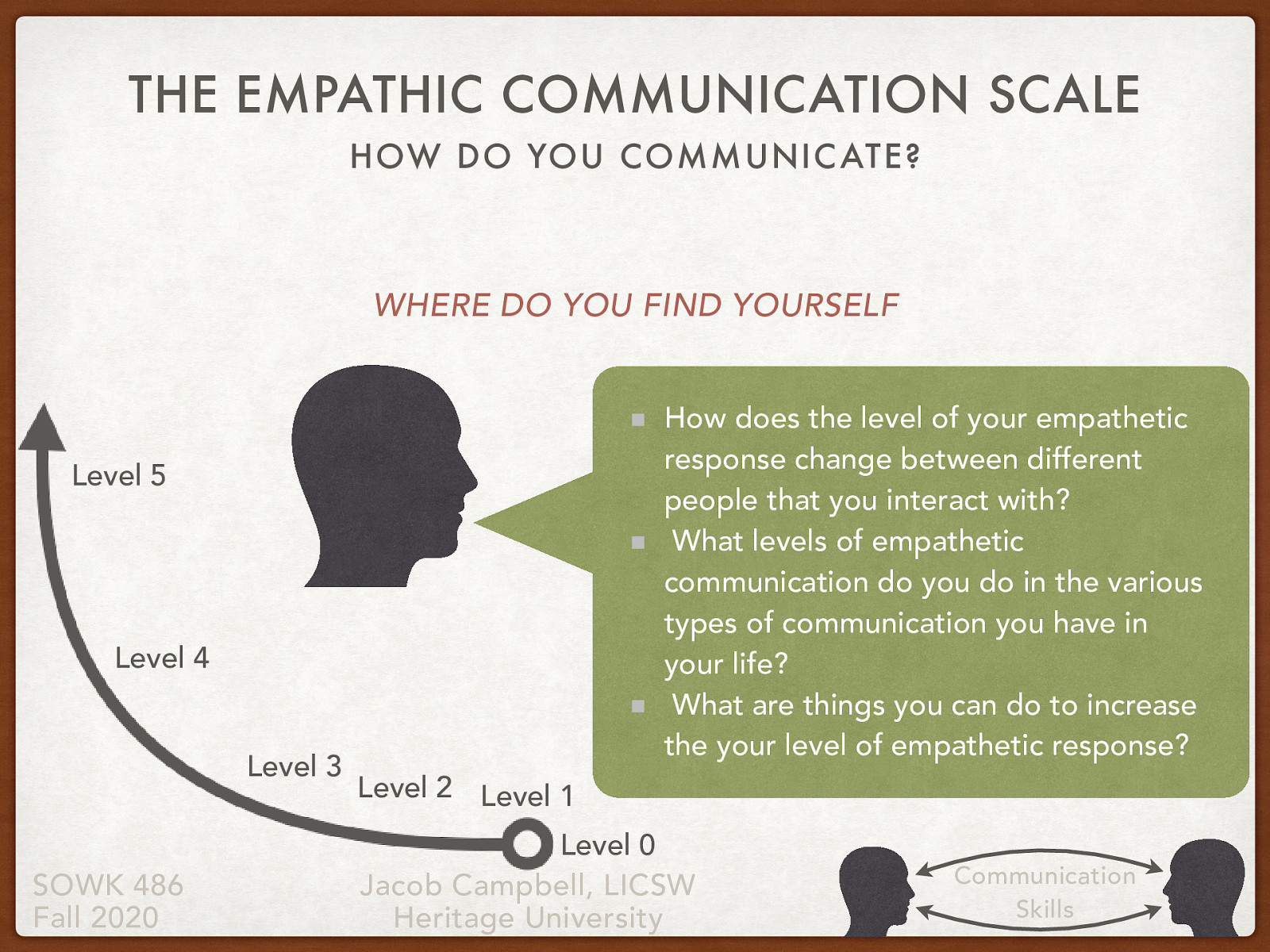
The Empathic Communication Scale (8 of 8)
While we do not need to be in all of our relationships, or in every arena. I believe it can be helpful for us to self evaluate ourselves and what levels we might be at.
[Small Group Activity] Partner discussion with the following points:
- How does the level of your empathetic response change between different people that you interact with?
- What levels of empathetic communication do in the various types of communication you have in your life?
- What are things you can do to increase the your level of empathetic response?
The focus of week six for SOWK 486 is on communication skill/s. There are many what Hepworth et al. (2017) term as discrete verbal following skills. Rogers (1957), who developed the concept of person-centered counseling, described what he called the facilitative condition. This includes empathy, unconditional positive regard, and congruence. He proposed that when clinicians can maintain these aspects, they are able to support and help promote positive changes in their clients. The plan for today is to talk about the core skills that help clinicians be able to help their clients. The agenda is as follows:
- The Facilitative conditions
- Empathy
- Authenticity
- The Empathic Communication Scale
